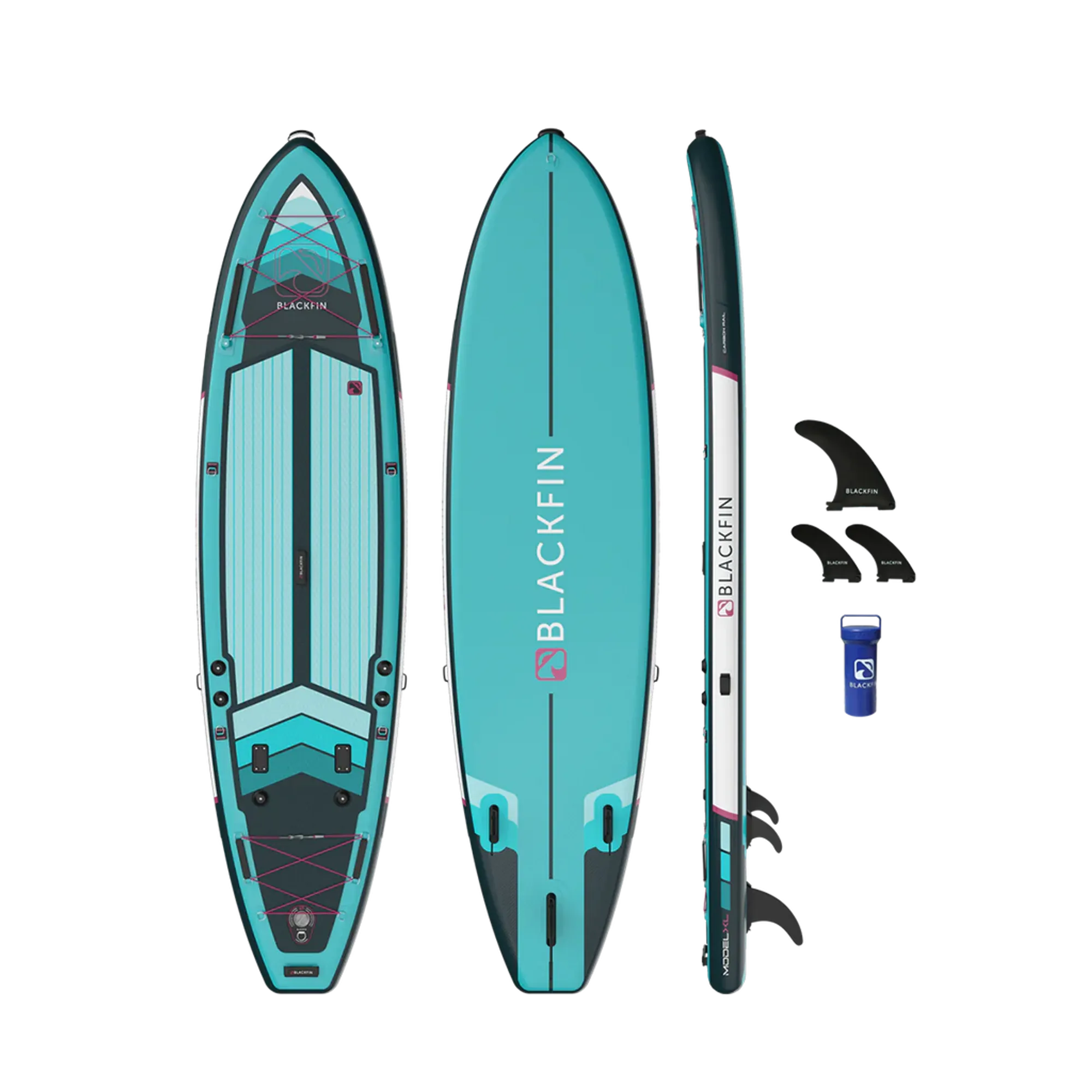Stories

Welcome, fellow adventurers and paddle boarding enthusiasts! Pack your paddle boards and sunblock as we journey to Miami, the sun-soaked paradise that's a dream come true for anyone with a passion for the great outdoors. This paddle boarding Miami experience will be like no other, combining the thrill of exploring vibrant waterways with the sheer bliss of soaking up the Florida sun.
From the tranquil azure of Biscayne Bay to the tropical splendor of the Florida Keys, let's dive into some of Florida's dreamiest destinations for unforgettable stand-up paddle boarding experiences.
DISCLAIMER: Before traveling to a paddle location, ensure that the location still allows for paddle boarding and make yourself aware of any rules and regulations in place.
1. Biscayne Bay
Biscayne Bay is an amazing paddle boarding Miami destination. Biscayne Bay offers the best of both worlds. The northern end is surrounded by the bustling Miami metropolitan area, while the southern end is undeveloped and included in the Biscayne National Park. If you want to enjoy the spectacular view of the Miami skyline, it's recommended to paddle at night when the city lights are most breathtaking.

Image Source: Wikimedia Commons
As you move down towards the southern end of the bay, you'll enter the Biscayne National Park, which works to preserve the bay and its offshore barrier reef. The shores are lined with extensive mangrove forests that provide a natural habitat for juvenile marine life and several other animal species.
- Water types and skill levels: The calm waters of the bay make it easy for beginners to practice paddling without worrying about waves or currents.
- Launch points: There are numerous spots to launch from along the shores of Biscayne Bay due to its vast size, such as Morningside Park, North Bay Village, Sunset Islands, and West Island Park
- Amenities: Parking, restrooms, showers, and picnic areas, with water sports rentals available at select launch points.
- Unique features: Breathtaking views of the Miami skyline, diverse marine life, and Biscayne National Park
2. Oleta River State Park
Oleta River State Park is a large urban park in Florida that spans over 1,000 acres of natural beauty. The park provides an excellent opportunity to escape the noise of the city and enjoy the tranquility of nature. Visitors can paddle along the Oleta River, which flows into the Biscayne Bay, and explore the amazing mangrove ecosystem that is home to a variety of birds, fish, and mammals.
Additionally, visitors can paddle to Sandspur Island, a peaceful island with a quiet beach and clear water. Oleta River State Park is a great paddle boarding Miami destination for nature lovers and adventurers who enjoy paddle boarding.
- Skill: Beginner to advanced
- Water type: Calm, brackish, and shaded
- Launch points: Main entrance of the park or the Blue Moon Outdoor Center
- Amenities: Parking, restrooms, showers, picnic areas, camping, cabins, bike trails, and water sports rentals
- Fee: $6 per vehicle or $4 per single-occupant vehicle
- Access: Open year-round, 8 a.m. to sunset
- Unique features: Lush mangrove tunnels, abundant wildlife, and a secluded beach
3. North Bay Village
North Bay Village is a small island community that connects Miami to Miami Beach via the John F. Kennedy Causeway. It is a convenient and scenic place to start your paddle boarding Miami adventure and explore the surrounding waters of Biscayne Bay.
You can paddle along the shoreline and enjoy the spectacular views of the skyscrapers and boats or head to nearby islands, such as Pelican Island and Bird Key, where you can find some peace and solitude. North Bay Village is also a great spot to see dolphins and manatees, especially during early mornings and late afternoons.
- Skill levels: Beginner to intermediate
-
Water type: Flat, calm, and deep water, perfect for paddle boarding.
- Launch points: Pelican Harbor Marina
- North Bay Village Marina
- Amenities: Parking, restrooms, showers, picnic areas, and water sports rentals
4. Sunset Islands
In the heart of Miami lies the Sunset Islands. True to their name, they serve up the most captivating sundown imaginable. Paddle boarding here feels like sailing on an artist's masterpiece, each stroke reflecting the ethereal blend of pink, orange, and gold.

Image Source: Flickr
Paddle boarding around the Sunset Islands is a great way to admire the architecture and the lifestyle of the rich and famous, as well as the spectacular views of the sunset over the bay. You can also paddle to the nearby Belle Isle, where you can visit the historic Venetian Pool, a public swimming pool that was built in 1924.
- Water types and skill levels: The calm waters of Biscayne Bay make Sunset Islands suitable for all skill levels.
- Launch points: Sunset Harbour Marina or Purdy Avenue Boat Ramp
- Amenities: Parking, restrooms, showers, picnic areas, and water sports rentals
- Fee: Free or minimal parking fee
- Unique features: Stunning views of the sunset, luxurious mansions, and a chance to see celebrities. Also, the sunset glow tour offered by Miami Beach paddle board provides an amazing paddle boarding Miami experience at night with LED lights.
5. Florida Keys
The Florida Keys are a chain of islands that stretch for about 120 miles from the southern tip of Florida. They are a world-renowned destination for water sports, especially paddle boarding. You can paddle along the turquoise water, exploring the coral reefs, the shipwrecks, and the marine sanctuaries that are home to hundreds of species of fish, turtles, sharks, and rays.

Image Suorce: Wikimedia Commons
You can also paddle to the islands, such as the Dry Tortugas, where you can visit the historic Fort Jefferson, a 19th-century military fort that is now a national park. The Florida Keys are a paddle boarding Miami heaven for those who love the ocean and its wonders.
- Skill levels: Intermediate to advanced
- Water type: Choppy, clear, and deep
- Launch points: Various locations along the Keys, such as Islamorada, Marathon, and Key West
- Amenities: Parking, restrooms, showers, picnic areas, camping, hotels, restaurants, and water sports rentals
- Access: Open year-round, sunrise to sunset
- Unique features: Crystal-clear water, coral reefs, shipwrecks, and diverse marine life
6. Morningside Park
Morningside Park is a 42-acre bayfront park that is located in the Morningside neighborhood, a historic residential community in Miami’s Upper East Side. The park offers a serene and scenic setting for paddle boarding, with its tree-lined boulevards and its mangrove shoreline.
You can paddle along the calm and clear water, admiring the architecture and the gardens of the houses along the shore, or explore the nearby islands, such as the Bird Key and the Star Island, where you can see more luxurious mansions and celebrities. Morningside Park is also a great place to see manatees and dolphins, especially in the winter months.
- Water types and skill levels: Calm waters, perfect for paddle boarders of all skill levels. Sometimes, depending on the day, the water can be calm or somewhat rough, providing a unique experience each time.
- Launch Points: Morningside Park has a small ramp for launching paddle boards located on the shore of the park.
- Amenities: Morningside Watersports offers a variety of watersports rentals, including stand up paddle boards, kayaks, pedal boats, and canoes. They also sell top-of-the-line equipment and offer storage for your personal equipment.
- Unique Features: Paddle boarding Miami in Morningside Park gives you the opportunity to paddle around several small islands in Biscayne Bay. Historic neighborhood, mangrove shoreline, and a chance to see manatees and dolphins
7. West Island Park
West Island Park is a 14-acre island park that is located in the western part of Biscayne Bay. It is a hidden gem for paddle boarding in Miami, offering a peaceful and secluded environment away from the city noise.
You can paddle along the calm and shallow water, exploring the mangrove forests that cover the island, or paddle to the nearby islands, such as Pelican Island and Bird Key, where you can find more natural beauty and wildlife. West Island Park is a great place to see birds, fish, and crabs, as well as dolphins and manatees.
- Skill: Beginner to intermediate
- Water type: Flat, calm, and shallow
- Launch points: Main entrance of the park or the West Island Watersports Center
- Amenities: Parking, restrooms, showers, picnic areas, and water sports rentals
- Fee: Free or minimal parking fee
- Unique features: Peaceful and secluded island, mangrove forests, and a chance to see wildlife
8. Key Biscayne
Key Biscayne is a barrier island that separates the center of Biscayne Bay from the Atlantic Ocean, and it's truly a magical place to paddle board. The island has a harbor and sandbar on its west side and beautiful white sand beaches on its east. Key Biscayne is a tropical paradise for paddle boarders, offering a variety of locations and activities. You can paddle along the calm, clear waters and explore the beautiful beaches and diverse marine life.

Image Source: Flickr
Accessible by car from Miami, Key Biscayne offers an island lifestyle that's perfect for paddle boarding in Miami. The beaches on this key are some of the most beautiful and secluded beaches in all of Miami. You can enjoy your own private paddle boarding Miami experience away from the noise and general public while still being close to the city.
- Skill: Beginner to advanced
-
Water type: The sloping beachfront at Biscayne Bay provides a tranquil launching location for stand up paddle boarders.
- Launch points: Various locations along the key, such as Crandon Park, Virginia Key, and Key Biscayne National Park
- Launching your paddle board will be easier on the west side of the key, which faces the mainland. We recommend that you stay on the west side of the island to avoid direct headwinds that may cause choppy waters and to avoid the open ocean.
- Amenities: These are available at some launch points, including parking, restrooms, showers, picnic areas, and water sports rentals.
- Fee: Free or minimal parking fee
- Unique features: Beautiful beaches, crystal-clear water, and diverse marine life
9. Miami Marine Stadium
Miami Marine Stadium, built in 1963, was initially constructed for powerboat racing, and it was used for this purpose for almost 30 years. It is now an abandoned venue, located just up the road from Key Biscayne, and is a great paddle boarding Miami location.
The stadium sits right on the waterfront, surrounded by mangrove trees and sandbars, making it an ideal spot to explore the nearby waters and see the wildlife and bird species that have made the mangrove environment their home. With numerous islands or "sandbars" to hop on and off, paddle boarding at Miami Marine Stadium provides a fun island-hopping adventure.
- Skill: Beginner to intermediate
- Water type: Flat, calm, and deep
- Launch points: Direct from Miami Marine Stadium
- Amenities: There are some parking places, restrooms, showers, picnic areas are well maintenance and water sports rentals
- Unique features: Historic stadium, city views, and a chance to see dolphins and manatees
10. South Beach
South Beach, like Key Biscayne, blocks the north end of Biscayne Bay from the Atlantic Ocean. Its eastern side boasts stunning white sand beaches that are perfect for paddlers, along with towering skyscrapers in the background.

Image Source: Flickr
This is the real Miami to us - long stretches of soft sand, crystal-clear water that's great for beginners, and a beautiful cityscape right behind you.
- Skill: Beginners to advanced paddlers
- Water type: Flat, calm, clear and shallow
- Launch points: Various locations along the beach, such as the South Beach Marina or the South Beach Watersports Center
- Unique features: Beautiful beach, crystal-clear water, and a vibrant nightlife
11. Virginia Key
Virginia Key is a small island that is located between Miami and Key Biscayne. It is a peaceful and scenic spot to paddle board, offering a close-up view of the city and the bay.

Image Source: Wikimedia Commons
You can paddle along the calm and shallow water, exploring the nature trails and the historic lighthouse, or paddle to the nearby islands, such as Fisher Island and Star Island, where you can see more luxurious mansions and celebrities. This is also a great place to see birds, fish, and crabs, as well as dolphins and manatees.
- Water Types: Calm and clear, making it an ideal paddle boarding Miami location. The beach is known for its white sand, coral reefs, and calm waters.
- Skill Levels: Virginia Key offers something for all paddlers. Beginners can take paddle board lessons, while experienced paddlers can explore the area's clear and calm waters.
- Launch Points: The main launch point for paddle boarding in Virginia Key is the Virginia Key Outdoor Center. Another popular spot is the PADL flagship location on Virginia Key.
- Amenities: Kayak, paddle board, and bike rentals. PADL offers self-service rentals accessible right from your smartphone.
- Unique features: Historic lighthouse, nature trails, and a chance to see wildlife
12. Hobie Beach
Hobie Beach is a popular and dog-friendly beach that is located on the Rickenbacker Causeway. It is a fun and relaxing place to paddle board, offering a close-up view of the city and the bay. You can paddle along the calm and shallow water, enjoying the views of the skyscrapers and the boats, or paddle to the nearby islands, such as Fisher Island and Star Island, where you can see more luxurious mansions and celebrities.
Hobie Beach is also a great place to see dolphins and manatees, especially in the early morning or late afternoon.
- Skill levels and water types: The waters around Hobie Beach are typically calm and clear, making it perfect for beginners, while more experienced paddlers can venture further out.
- Launch points: Main entrance of the beach or direct from the Hobie Beach Watersports Center
- Amenities: There are parking places, restrooms, showers, picnic areas are well-maintenance, and water sports rentals
- Unique features: One of the unique features of paddle boarding Miami at Hobie Beach is its location. It’s situated on the Rickenbacker Causeway, providing stunning views of the Miami skyline. Moreover, it’s known as Miami’s most popular beach for windsurfers and dog lovers.
13. Venetian Islands
The Venetian Islands are located south of North Bay Village and run through Biscayne Bay. The Venetian Islands are a chain of six artificial islands that are located between Miami and Miami Beach. They are connected by the Venetian Causeway, a scenic road that offers stunning views of the city and the bay. These islands are perfect for launching your SUP and paddling in.
Venetian Islands are known for their luxurious mansions and stunning views of the Miami skyline. You can paddle along the calm and shallow water, admiring the architecture and the lifestyle of the residents, or paddle to the nearby islands, such as Hibiscus Island and Palm Island, where you can see more extravagant mansions and celebrities. The Venetian Islands are a paddle boarding Miami delight for those who love the city and the bay.
- Skill levels: The waters surrounding the island chain are relatively calm, making them beginner-friendly.
- Water Types: Relatively calm, the turquoise-blue waters offer a stark contrast to the city's skyscrapers, providing a unique backdrop for your paddle boarding adventure.
- Launch Points: There are numerous launch points along the shores of the Venetian Islands¹. However, it's important to keep a safe distance from the homes and do not dock or paddle down any canal, as these are privately owned piers and beaches.
- Unique features: Beautiful views of the city and the bay, elegant homes, and a chance to see celebrities.
Note: To ensure your safety and avoid any potential trespassing, you should maintain a safe distance from the private homes and refrain from docking or paddling down any of the canal's privately owned piers and beaches.
14. Haulover Beach
Haulover Beach is a unique and lively beach that is located in the northern part of Miami Beach. It is known for its nude section, which is one of the few legal clothing-optional beaches in the United States. Paddle boarding Miami on Haulover Beach is a fun and liberating experience, with the waves, the sun, and the people adding to the excitement. You can paddle along the shoreline, enjoying the views of the skyscrapers and the boats, or paddle to the nearby islands, such as Fisher Island and Star Island, where you can find some peace and solitude.

Image Source: Wikimedia Commons
Haulover Beach is a paddle boarding hotspot for those who love the beach and the freedom.
- Skill levels and water type: The beach is known for its turquoise blue waters of the Atlantic Ocean, which can range from calm to moderately choppy depending on the weather, making it an exciting spot for both beginners and experienced paddle boarders.
- Launch points: One of the most popular is from Oleta State Park. Other nearby harbors like Bill Bird Marina or Bal Harbour also provide access to Haulover Sandbar.
- Amenities: The beach is well-equipped with amenities such as paddle board rentals, restrooms, picnic areas, and food concessions, making it a convenient spot for a day of paddle boarding.
-
Unique features:
- City views and a chance to see dolphins and manatees.
- Another unique feature is the presence of a designated area for naturists, making Haulover Beach one of the very few government-sanctioned clothing-optional beaches in the United States. However, the paddle boarding areas are separate and family-friendly.
Paddle Boarding Safety in Miami
Miami, with its sun-soaked coastlines and vibrant marine life, offers an exhilarating yet challenging environment for paddle board enthusiasts. Here are some key safety measures to consider ensuring a fun and secure paddle boarding Miami experience in this dynamic city.

1. Understanding Miami’s Weather & Water Conditions
When it comes to paddle boarding Miami activities, understanding the local weather and water conditions is crucial. Miami's tropical climate is typically warm, but it's also prone to sudden showers. Stay updated with the weather forecasts and respect the sea's might at all times.
2. Safety Gear and Practices for Paddle Boarding
Paddle boarding safety is paramount when you're on the water. Stay hydrated, apply sunblock, and be aware of your surroundings. If you're new to paddle boarding, consider taking a class to get the hang of it. Here are some safety measures to consider:
- Personal Flotation Device (PFD): The U.S. Coast Guard classifies stand-up paddle boards as vessels. Therefore, if you're outside a swimming or surfing area, you must have a U.S. Coast Guard-approved PFD on board. For children under 13, the PFD must be worn at all times.
- Whistle: It's required to carry a whistle to warn other boaters. In limited visibility conditions, such as fog, you must also have a flashlight.
- Leash: Many experienced paddle boarders recommend using a leash, as it can prevent your board from drifting away if you fall into the water.
- Right of Way: Generally, stand-up paddle boarders must yield to larger, less maneuverable vessels. It's also a good practice to avoid high-traffic areas and remain aware of your surroundings.
How to Paddle Board Responsibly and Sustainably
Paddle boarding is not just a sport but an intimate communion with nature. As we glide through the waters, it's vital to remember our role as stewards of the environment. Steer clear of interrupting marine life, maintain respectful distances from the gentle manatees and playful dolphins, and commit to leaving the water purer than when you arrived.
Restrictions or Regulations for Paddle Boarding in Miami
When it comes to paddle boarding in Miami, certain rules and regulations ensure the safety of everyone on the water and protect the local environment. Check with local authorities for the most updated regulations, but here are some general guidelines:

- Alcohol and Drugs: Just like driving, it's illegal to operate a paddle board while under the influence of alcohol or drugs.
- Wildlife Regulations: Respect local wildlife. Keep a safe distance from manatees, dolphins, and other marine life.
- Permits and Designated Zones: Some parks and protected areas may require permits for paddle boarding, or may limit paddle boarding to designated zones. Always check the specific regulations for the area where you plan to paddle board.
Remember, it's your responsibility to stay updated on local regulations and to follow them. Your safety, and the safety of others around you, depends on it.
Are You Ready To Make Waves in Miami?
Don't let this adventure pass you by! It's time to gear up with iROCKER's inflatable SUP and paddle out into the clear, inviting waters of Miami. Feel the sun on your skin, the sea breeze in your hair, and the thrill of exploration in your heart. Your paddle boarding Miami adventure will help you experience life in a whole new light. So, who's with us? Let's make some waves!

Primed for an exhilarating dive into adventure? Grab your stand up paddle board and get set to navigate the sparkling jewels of the Emerald City from its shimmering waterways. Paddle boarding Seattle presents an unmatched blend of serene nature and the city's striking skyline, truly offering an extraordinary paddle boarding Seattle experience.
Before you dive into the emerald waters, let's kit up! In Seattle, the weather can be as unpredictable as a sea lion's antics, so come prepared. A trusty wetsuit, a reliable Personal Flotation Device (PFD), and non-slip water shoes are your first mates in this venture. Also, don’t forget your UV protection, hydration pack, and waterproof bag for personal belongings. Now, let's set sail to the top paddle boarding spots in Seattle.
DISCLAIMER: Before traveling to a paddle location, ensure that the location still allows for paddle boarding and make yourself aware of any rules and regulations in place.
1. Moss Bay
Located on the picturesque south side of the lake, Moss Bay is a serene and breathtaking paddle boarding Seattle spot that offers a perfect opportunity for tourists and locals alike to explore the charming houseboat communities and enjoy stunning city views from the tranquil waters.

Image Source: Flickr
Moss Bay is bursting with a vibrant marine ecosystem and you can get up close and personal with frolicking seals and otters. Whether you are a beginner wave-catcher or a seasoned sea rover, Moss Bay's tranquil waters are a paddle boarder's utopia. You can rent a kayak, canoe, or paddle board from Moss Bay Rental which is conveniently located on the waterfront.
- Skill Level: Ideal for beginners or first-time paddle boarders to hit the water and learn the basics.
- Water types: tranquil waters with little to no current
- Amenities: Moss Bay offers guided tours and kid camps, making it a perfect spot for families and groups. The area is also rich in rental facilities, offering a hassle-free start for those without equipment.
- Launch Points: Directly from Moss Bay
2. Lake Washington, North
Up next, we have the magnificent Lake Washington. This freshwater lake offers a nice and relaxing alternative to the other paddle boarding Seattle spots around. Paddlers of any level can enjoy the super calm waters and take in breathtaking views of Mt. Rainier.
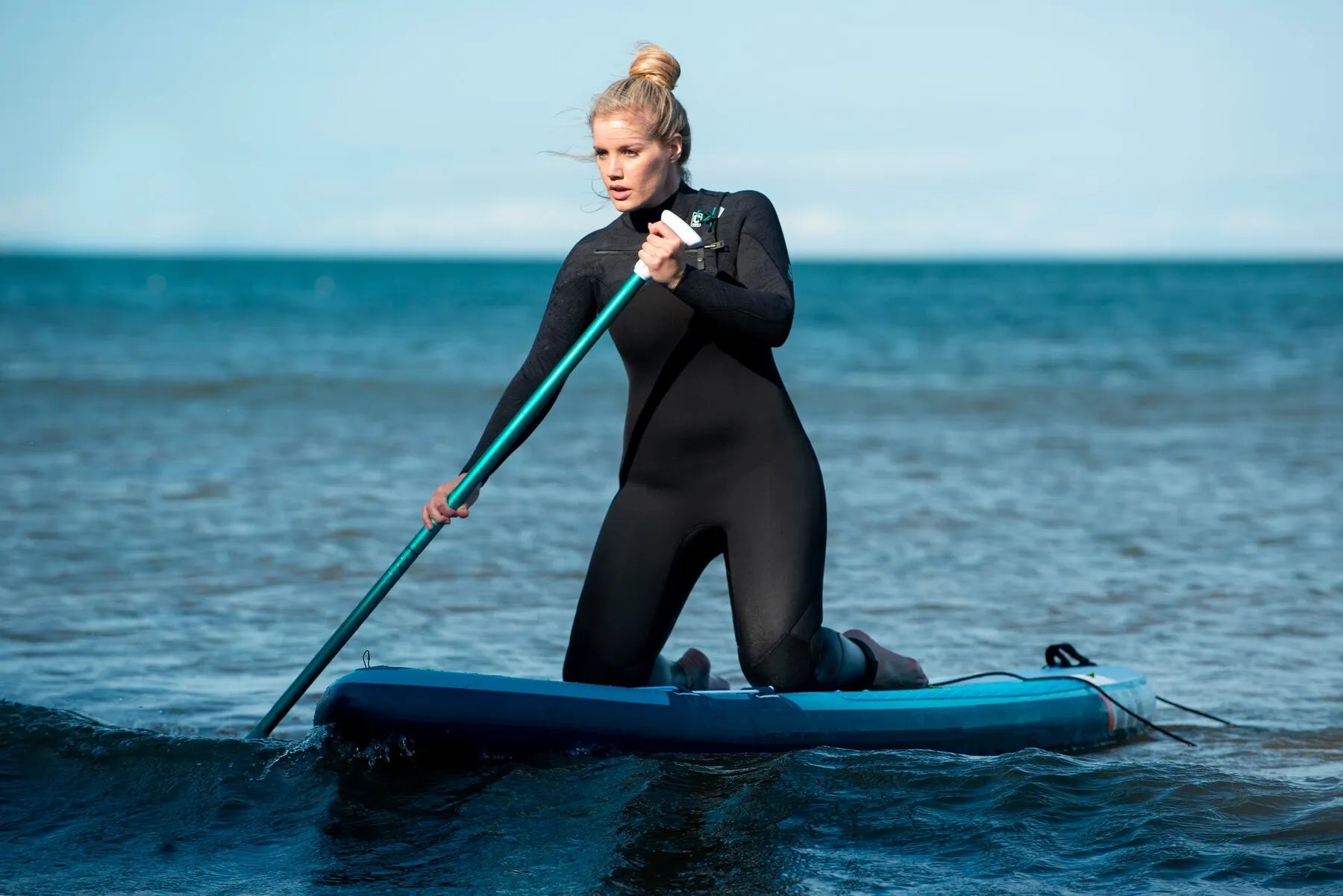
Head over to Lake Washington North for a serene oasis that contrasts sharply with the lively hustle and bustle of Seattle. Paddle through calm waters with the majestic Mt. Rainier standing tall in the background.
- Skill levels: These serene waters are perfect for any level of paddler to enjoy while taking in breathtaking views.
- Launch points: For easy access to the water, launch your boat at Matthews Beach Park, St. Edward Park, or Sand Point.
Note:
- Be cautious of gusty winds over the lake that typically occur in the afternoon.
- An early morning paddle here offers a refreshing start, setting the perfect tone for your day.
3. Seward Park
Seward Park is a popular paddle boarding Seattle destination. It's situated in the southern part of Lake Washington and is surrounded by the lake's crystal-clear waters. Seward Park is a perfect place to experience the beauty of nature while paddle boarding amidst lush greenery.
This is the ultimate stand-up paddle boarding experience in Seattle that truly captures the city's essence. The location is ideal for paddle boarding as the waters are relatively calm, and the views are breathtaking.
- Skill levels: Park is the place to be for both beginners and intermediate paddlers.
-
Water Type: Calm lake waters
- Launch points: The best and easiest launch site is located at Andrews Bay, which is opposite Mercer Island.
- If you're up for a challenge, try kayaking from Seward Park around Mercer Island and under Seattle's iconic bridges.
Note: Experienced paddlers should join a more adventurous route; the paddle around Mercer Island presents a delightful challenge to view some of Seattle’s iconic bridges.
4. Alki Beach
If you are a fan of paddle boarding, you must visit Alki Beach in West Seattle. It is a long and wide sandy beach that offers a stunning view of downtown Seattle and the Olympic Mountains. Several rental shops in the area provide paddle board rentals.

Image Source: Flickr
The view of the Seattle skyline from the beach is breathtaking. You can paddle out and witness the beauty of the city's towering skyscrapers and the majestic Olympic Mountains in the backdrop. So, head out to Alki Beach for a serene and picturesque paddle boarding Seattle experience.
- Skill levels: The beach is perfect for beginners and those looking for a challenge.
-
Water types: The waves can be challenging, but it's a great spot to test your ride-the-waves skills.
- Launch points: Start your paddle from Salty's Restaurant, which also offers a great menu after your session.
- Alki Point Lighthouse and Lincoln Park are also easy to access from here.
Note: The summer months can get crowded with beachgoers and other paddle boarders.
5. Lake Union
Lake Union is an absolute paradise for paddle boarding Seattle enthusiasts. This stunning freshwater lake is situated right in the heart of the city, offering breathtaking views of the Seattle skyline. If you're riding solo and looking to make friends, Lake Union is the perfect spot to meet other paddle boarding enthusiasts.

Image Source: Wikimedia Commons
You'll be surrounded by a vibrant community of like-minded individuals who share your passion for adventure and exploration. Be sure to bring your action camera along to capture some unforgettable moments of the picturesque scenery. With its crystal-clear water, serene atmosphere, and stunning views, Lake Union truly is a haven for anyone who loves paddle boarding.
- Skill levels: From beginners to intermediate paddlers.
- Launch points: There are multiple locations around the lake where you can launch your paddle board. Sunnyside boat ramp at the north end of the lake and the docks near Moss Bay Rentals are easy to access.
- Amenities: We recommend that you stop by Ivar's Seafood House to try their world-famous Clam Chowder.
6. Green Lake
Green Lake is a popular spot for kayaking and paddle boarding Seattle enthusiasts. Surrounded by a park with a 2.8-mile path, it's perfect for walking, jogging, skating, or biking. Green Lake is often referred to as Seattle's central park. It's a great place to enjoy some sun and paddle around the calm waters.
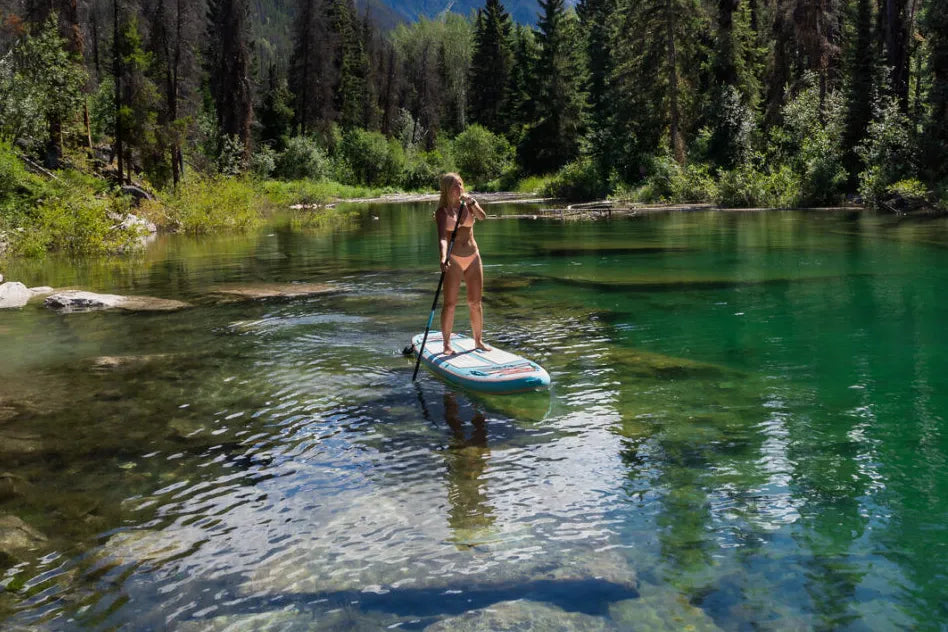
Whether you're a beginner or an intermediate, there are easily accessible entry points all around the lake. However, the west side of the lake offers a more peaceful experience with secluded areas. If you're looking for paddle boarding in the Green Lake area, Urban Surf is a great option. Urban Surf also offers unique experiences, from urban skyline views to tranquil lake environments.
- Skill levels: The lake is small and more enclosed, making it ideal for those who are new to paddle boarding or just looking for a more relaxed experience.
- Water type: Calm water with less winds and waves.
- Amenities: There are rental shops near the lake that offer paddle board rentals for those who don't have their own gear.
Note: Visiting this place on cloudy days and chilly days is also a good option since it can get crowded when it's sunny.
7. Meydenbauer Bay
Meydenbauer Bay is a small, serene, and picturesque bay located in the heart of Bellevue, which is a must go paddle boarding Seattle spot. It is a calm and sheltered spot that offers spectacular views of downtown Bellevue. You can launch your paddle board from the public boat launch available on the bay.
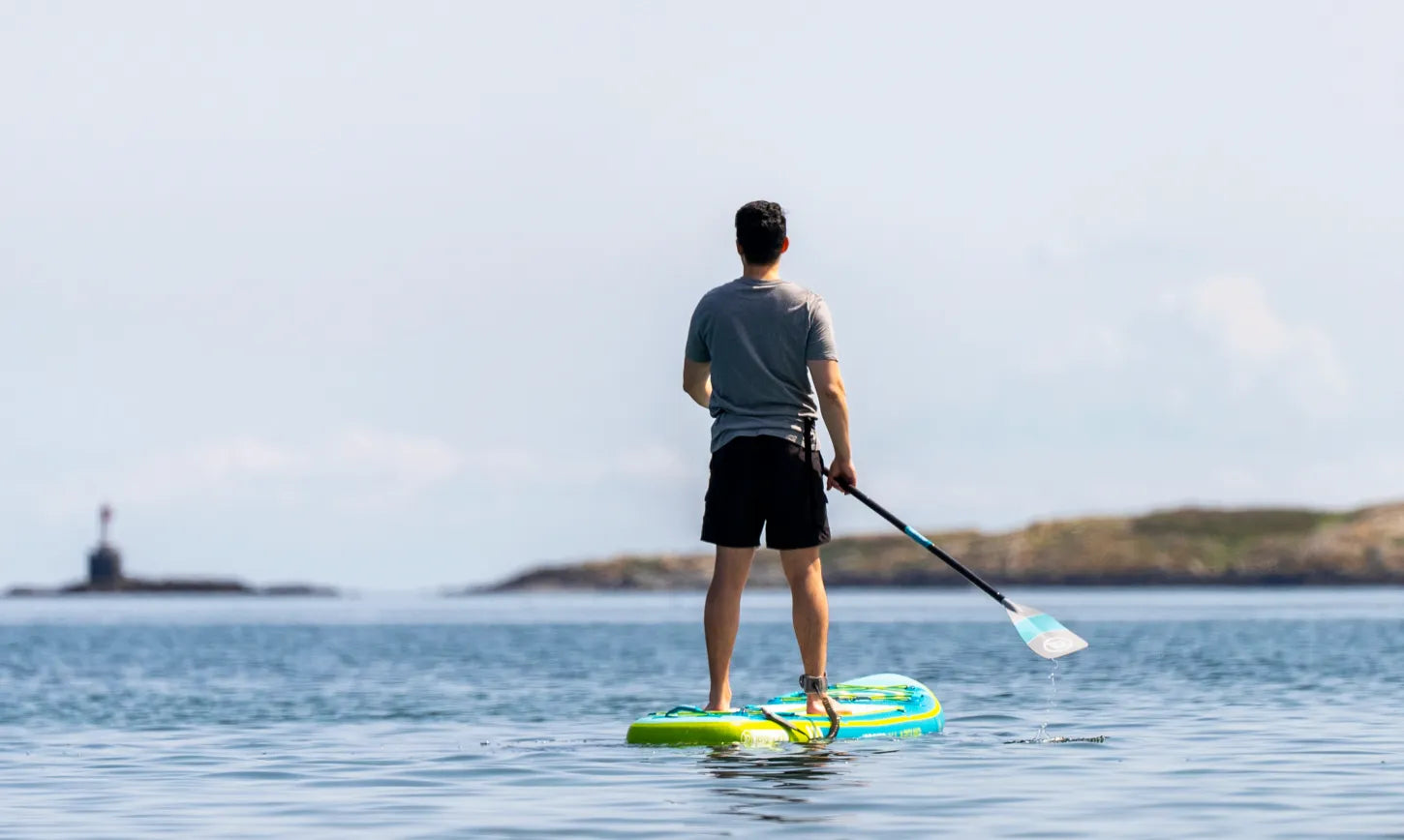
Meydenbauer Bay is a hidden gem in Bellevue that offers a peaceful experience with stunning views. It is especially suitable for intermediate-level paddlers, particularly during weekdays when it is less crowded. Meydenbauer Bay Park, situated on Lake Washington in Bellevue, is an excellent location to enhance your paddle skills. You can rent a canoe, kayak, or stand-up paddle board from the REI boathouse.
- Skill Level: Beginners who want to learn the basics and intermediate paddlers.
- Water Type: Sheltered bay with calm water and soft winds.
Note:
- This small bay offers stunning views of downtown Bellevue’s skyline. You should bring your camera so you do not miss the unforgettable views.
- It's delightful during the week as it is extremely busy on weekends.
8. Mercer Slough Nature Park
Mercer Slough Nature Park is a breathtaking 320-acre wetland located in the serene city of Bellevue. It is a perfect paddle boarding Seattle destination for those who love water activities, wildlife viewing, and exploring nature.

The park has a beautiful public boat launch that makes it convenient for you to launch your small watercraft and enjoy the calm and scenic waters. You can either bring your own small watercraft or rent one at Enatai Beach Park. Paddle boarding through the wetlands of Mercer Slough Nature Park is a unique experience that allows you to witness the beauty of nature up close. Mercer Slough is ideal for nature lovers. The park’s winding waterways are a haven for wildlife, providing a tranquil paddling experience away from the city’s noise. So, come and enjoy a peaceful adventure amidst the tranquility of this beautiful park.
- Skill Level: Intermediate paddlers
- Water Type: Wetland channels with the park’s winding waterways.
- Launch Points: From public Boat Launch.
9. Lake Sammamish State Park
Are you planning to take a break from the busy city life and go for a quick getaway? Lake Sammamish State Park is a spacious park located on the shores of Lake Sammamish, which is ideal for paddle boarding Seattle journey.

Image Source: Wikimedia Commons
The lake also features a deciduous forest, wetland vegetation, and three salmon-bearing streams. The park offers a variety of boats that are available for rent hourly. This could be the perfect location for your paddle boarding. It boasts several miles of shoreline and offers stunning views of the lake and the surrounding mountains. One can commonly spot eagles in this area.
- Skill levels: From beginners to intermediate paddlers who love nature.
- Water types: The water is calm, and you can even paddle over a sunken forest in the southern part, near Greenwood Point.
- Amenities: There are some restrooms along the lake. You can bring a small waterproof backpack, including some water and snacks.
Note: No matter what time of year you visit, this place is never crowded, which makes it perfect for beginners. Enjoy this paddle in nature and keep your eyes peeled for wildlife out on the water.
10. Arboretum
Nestled in the heart of the University District, west of Lake Washington, lies the Washington Park Arboretum, a sprawling 230-acre public park that's a nature lover's paradise. The park's lush greenery, native plants, and wetlands are home to a diverse range of wildlife, making it an ideal spot for nature paddle boarding Seattle enthusiasts and photography enthusiasts alike.
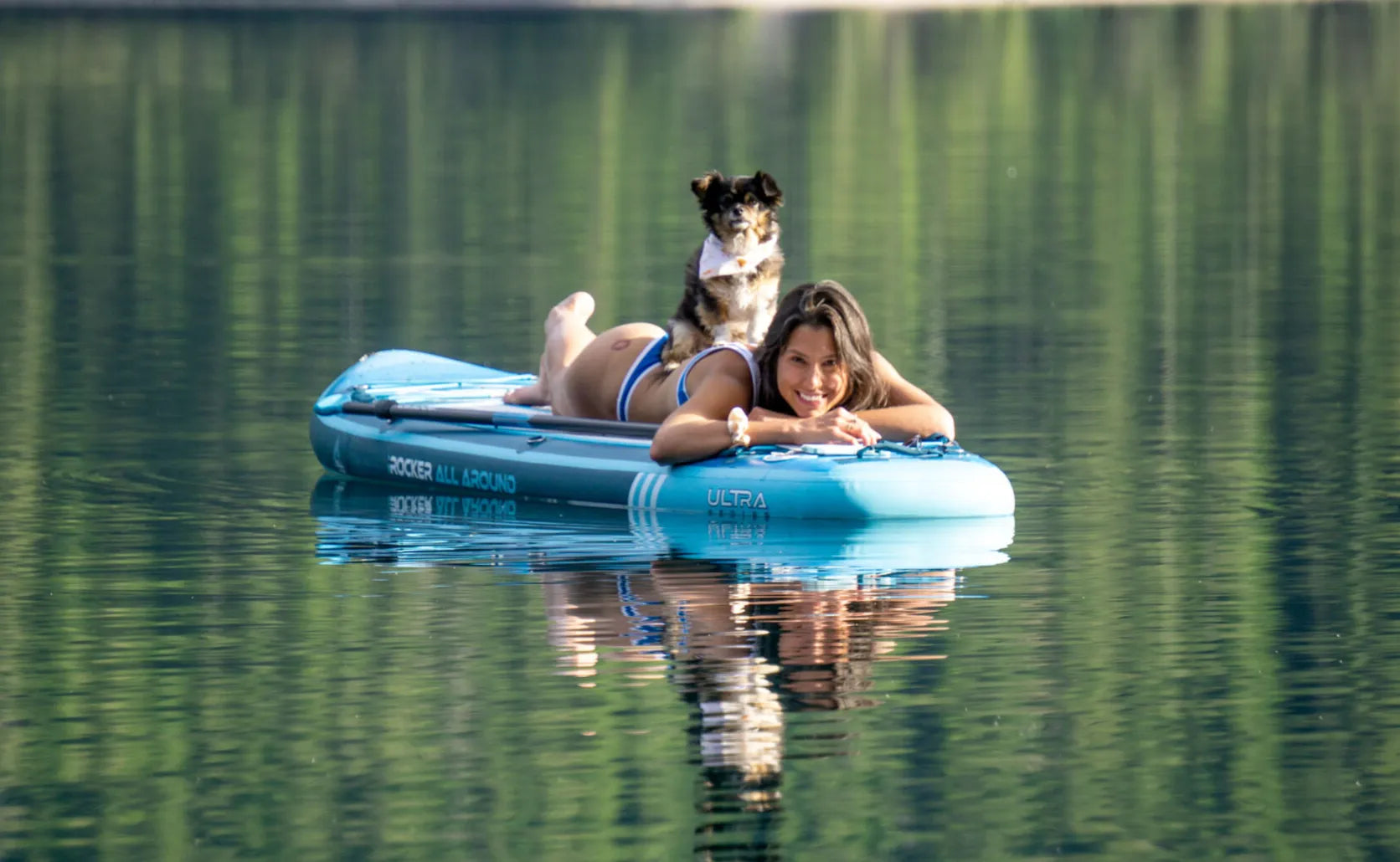
As you walk through the park, you'll be greeted by narrow waterways that wind through the trees, providing ample shade and a sense of calm. The waterways are home to hundreds of lilypads, docks, and bridges that create a unique and serene environment. Dubbed the "urban Everglades," the Arboretum offers a tranquil escape from the hustle and bustle of the city. It's a must-visit destination for anyone who appreciates the beauty of nature.
- Skill Level: Suitable for intermediate paddlers
- Water Type: Narrow, tree-shaded waterways
- Launch Points: From Washington Park Arboretum
11. The Ship Canal in Fremont
Situated between the picturesque Lake Union and the majestic Puget Sound, the Ship Canal at Fremont is an absolute paradise for paddle boarders seeking a thrilling challenge. As you navigate through the canal, you'll pass through the lush greenery of the Arboretum, where you'll be greeted by breathtaking views of Seattle's dazzling downtown skyline. This hidden gem is a well-kept secret among intermediate paddlers who are looking to push their limits and test their skills.
However, the pristine waters of the Pacific Northwest can be pretty chilly, even in the summertime. Therefore, it's essential to dress appropriately for your aquatic paddle boarding Seattle adventure. The Fremont region of the river offers unparalleled access to the Arboretum and unrivaled views of downtown Seattle. On the other hand, the U-District to the west allows you to witness an array of boats, including deep-sea fishing vessels that transport Seattle's world-renowned fresh seafood to Pike Place Market.
- Skill levels: This location is perfect for intermediate paddle boarders seeking a challenge. Although launching may be difficult, the experience is worth it.
- Launch points: If you want to take in the sights, hit the water at docks near S3 Maritime or Fisherman’s Terminal. However, be cautious of boats that pass through the canal and stick to the sides. You don't want to get caught out by a larger wake from a boat that can send you overboard.
- Water types: The Pacific Northwest is a stunning region, but the water can be pretty cold, especially during summer, so it's essential to dress appropriately for water activities.
12. Discovery Park
Nestled just a short 20-minute drive away from the bustling city of Seattle lies the serene and picturesque Discovery Park. This hidden gem is the ideal destination for those seeking a tranquil retreat for stand-up paddle boarding. Spanning over 500 acres, Discovery Park is the largest city park in Seattle, surrounded by the calm waters of the Puget Sound.
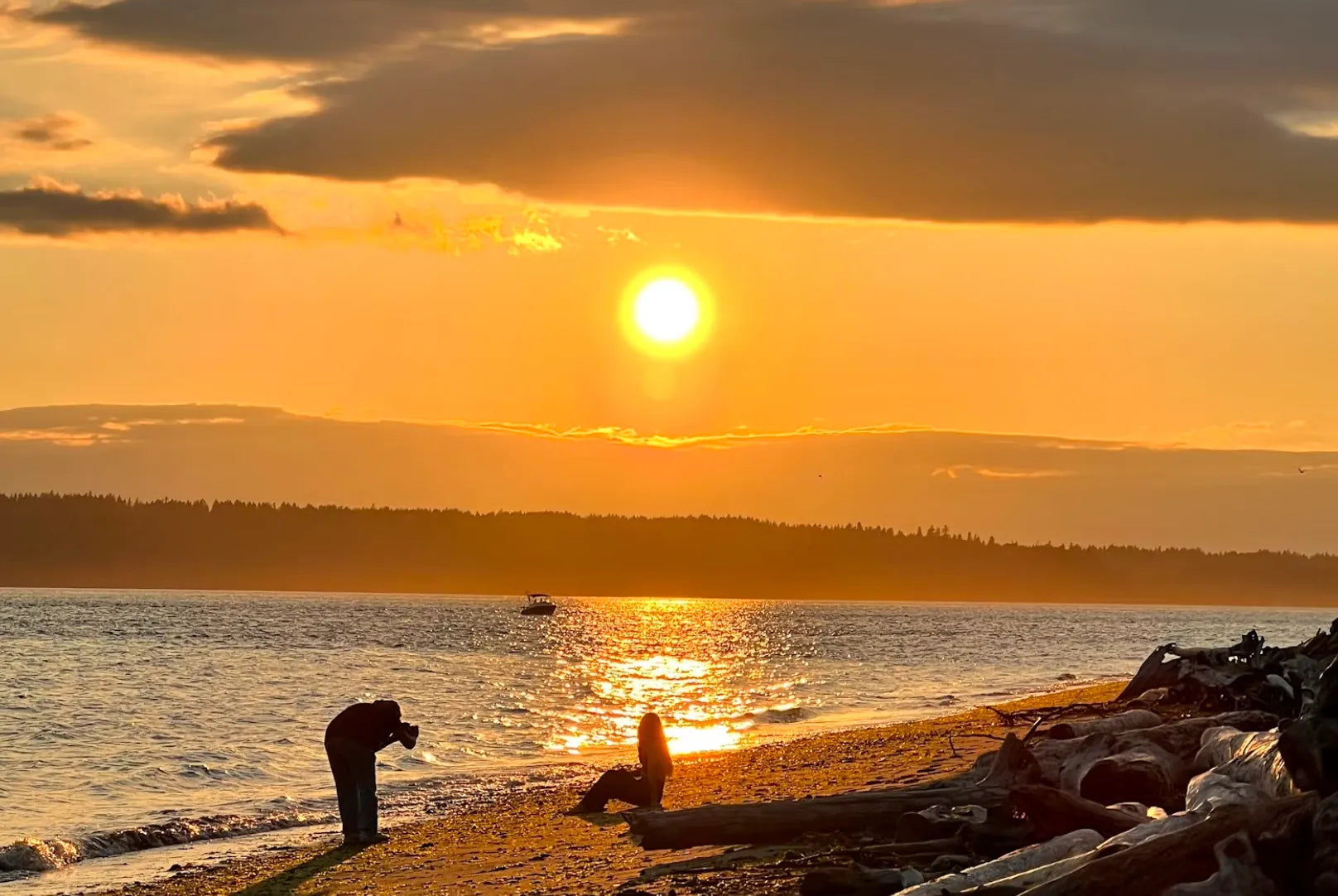
Image Source: Unsplash
Upon arriving at this natural wonder, you can bask in the stunning beauty of the Pacific Northwest as you paddle out onto the glistening waters of Puget Sound. The iconic waterbody of Seattle offers a unique perspective of the city as you glide through the peaceful waters. However, it's important to keep a watchful eye for boat traffic as you navigate your way through the Sound. Overall, Discovery Park is a must-visit destination for anyone looking for a serene and awe-inspiring stand-up paddle boarding experience away from the hustle and bustle of city life.
- Skill levels: Beginners to advanced paddlers
- Water types: Peaceful water, but keep your eyes on another boat around.
- Launch points: The West Point Lighthouse serves as the optimal location for launching your SUP, as it is located near the water’s edge.
- Amenities: There are parking places at the Westpoint Lighthouse.
Note: Don't miss the chance to explore some stunning hidden beaches by taking an off-the-beaten-track hike. You could even embark on a real adventure and make your way to "Surfer's Beach" at Point Shilshole.
13. Shilshole Bay and Golden Gardens
This location is a true gem with plenty to offer. It boasts beautiful beaches and stunning mountains as a backdrop, making it one of the top destinations in the Seattle area. Shilshole has everything you could ask for, whether you want to take a break from the world or go on a real getaway.

Image Source: Wikimedia Commons
The beaches are ideal for relaxation and even camping. The mountainous backdrop makes the spot even more incredible. You can get up close and personal with superb sea life right from your SUP. Additionally, you can make the most of your trip by visiting Golden Gardens, which is magnificent in late summer.
- Skill levels: From intermediate to experienced paddlers
- Launch points: To begin your adventure, you can park up and launch from the northern side of the marina. However, please be aware that this dock can be quite busy, especially on sunny days. You can also launch from Golden Gardens and navigate your way around Shilshole Marina.
Note: Make sure to check the tides and weather conditions before you set off.
14. Juanita Beach Park
If you're looking for a fun water activity to enjoy with your family, Juanita Beach Park is the perfect paddle boarding Seattle destination. The protected area boasts calm and safe waters, making it the ideal spot for beginners to get comfortable on a paddle board.

Image Source: Wikimedia Commons
Located in the beautiful Kirkland region on the serene northeast side of Lake Washington, Juanita Beach Park offers stunning views and a peaceful atmosphere, making it a great place to spend the day. Both Juanita Beach Park and Marina Park offer rental facilities, making it easy and convenient for you to rent paddle boards for the day and explore the beautiful waters of Lake Washington with your family.
- Skill Level: Ideal for families and beginner paddlers.
- Water Type: Calm-protected waters ensure a safe and enjoyable experience.
- Launch Points: Direct from Juanita Beach Park
- Amenities: It’s a great spot for leisurely paddles and picnics, with well-maintenance amenities close by.
15. Olympic Beach
And last but not least, we have Olympic Beach in Edmonds, a superb location for paddling. This spot allows you to relish the breathtaking view of the Olympics across the water. You can also enjoy the simple pleasure of watching the ferry’s comings and goings from a bench.
For paddle boarding, you have two options: launch your board from the north towards Brackett’s Landing or head south to the Edmonds Marina. While the southern route has more beach obstacles like logs, it offers a beautiful setting away from the ferry traffic. In summary, Olympic Beach in Edmonds provides a fantastic paddle boarding experience with stunning views of the Olympic Mountains.
- Skill Level: A picturesque location for paddlers who have intermediate to advanced skills
- Water Type: Saltwater with winds and waves
- Launch Points: Direct from Olympic Beach or with options to launch along the waterfront for varied experiences.
Unique Aspects of Paddle Boarding in Seattle
Seattle offers a truly distinctive stand up paddle boarding experience that combines natural beauty with the city's quirky charm. Let's navigate the ripples and waves of the Emerald City's paddle boarding scene together.
1. Weather Conditions
Seattle's weather mirrors the eclectic character of its waterways. Sunny days bestow tranquil waters, while overcast skies stir up a more adventurous wave, making paddle boarding in Seattle a riveting journey where each day brings a fresh thrill.
2. Local Paddle Boarding Culture
Seattleites have a deep-seated affection for water sports, with paddle boarding holding a special place. The city's paddle boarding scene is teeming with energy and camaraderie, boasting an array of rental shops, clubs, and annual races. Whether you relish solitary explorations or thrive in group paddles, you're bound to find your kinship here.
How to Stay Safe Paddle Boarding in Seattle
Safety is your true north when embarking on a paddle boarding Seattle expedition. Equip yourself with local rules of the water and always maintain a healthy respect for its power. Strap on your PFD and leash, remain alert to weather changes, and never underestimate the might of the Pacific Northwest's waters. If you're a paddle boarding novice, ponder over a class or guided tour to guarantee a secure yet exhilarating adventure.
Your Seattle Paddle Boarding Adventure Awaits with iROCKER
So why wait? Embrace the thrill of your paddle boarding Seattle adventure with iROCKER. Navigate the waters with style and grace, and let every paddle stroke draw you closer to the heart of the Emerald City.

Welcome, outdoor enthusiasts and SUP adventurers! Your quest for the ultimate paddle boarding journey has brought you to Dallas. Beyond its vibrant culture and iconic charm, Dallas shines as a haven for paddle boarding! So, gear up with your iROCKER paddle board, and let's explore the top paddle boarding Dallas hotspots together.
Grab your board! It is time to unveil what Dallas has in store for us!
DISCLAIMER: Before traveling to a paddle location, ensure that the location still allows for paddle boarding and make yourself aware of any rules and regulations in place.
1. Lake Texoma
Lake Texoma is one of the largest reservoirs in the US, spanning the border between Texas and Oklahoma. This spot is one of the most popular lakes in the region and is ideal for a weekend getaway, as it offers stunning scenery, calm waters, and dreamy sunsets.
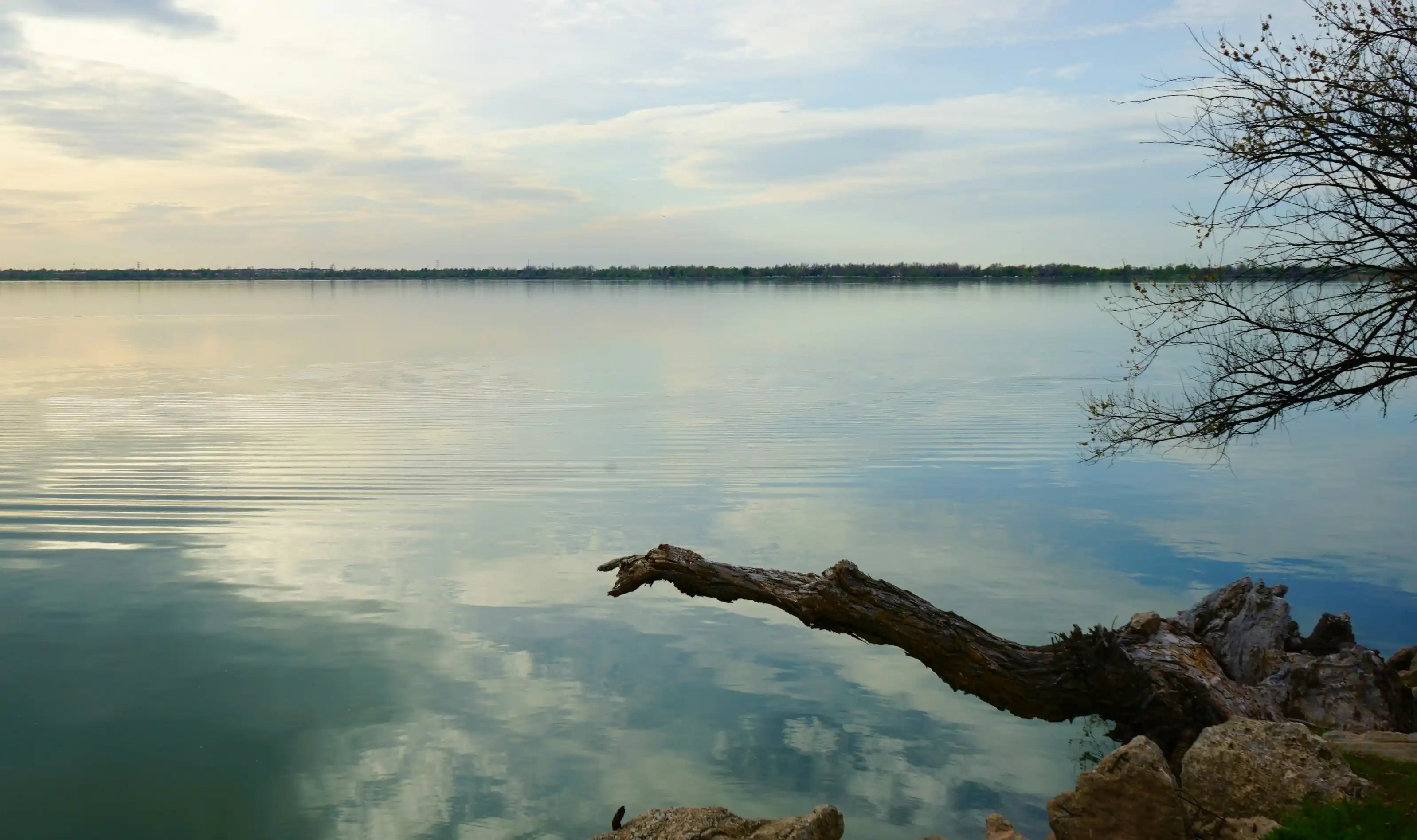
Image Source: Unsplash
You can also try SUP fishing, as the lake is home to various fish species, including striped bass, catfish, and crappie. There are Paddle Boarding Dallas rental stores near the lake, so you don’t need to bring your own gear.
- Skill level: Beginner to advanced
- Amenities: Boat ramps, marinas, campgrounds, and fishing docks
- Launch points: Eisenhower State Park, Highport Marina, and Lighthouse Marina are all around the lake, and you can launch from here.
- Fee: Varies by location
Note: Check the weather and wind conditions before heading out. Lake Texoma is a large lake, so it's recommended to plan your route ahead of time.
2. Grapevine Lake
Grapevine Lake in Texas is a popular paddle boarding Dallas destination and also ideal for boating, fishing, swimming, camping. The 8,000-acre lake has over 55 miles of shoreline and can be accessed from parks like Oak Grove Park and Meadowmere Park.
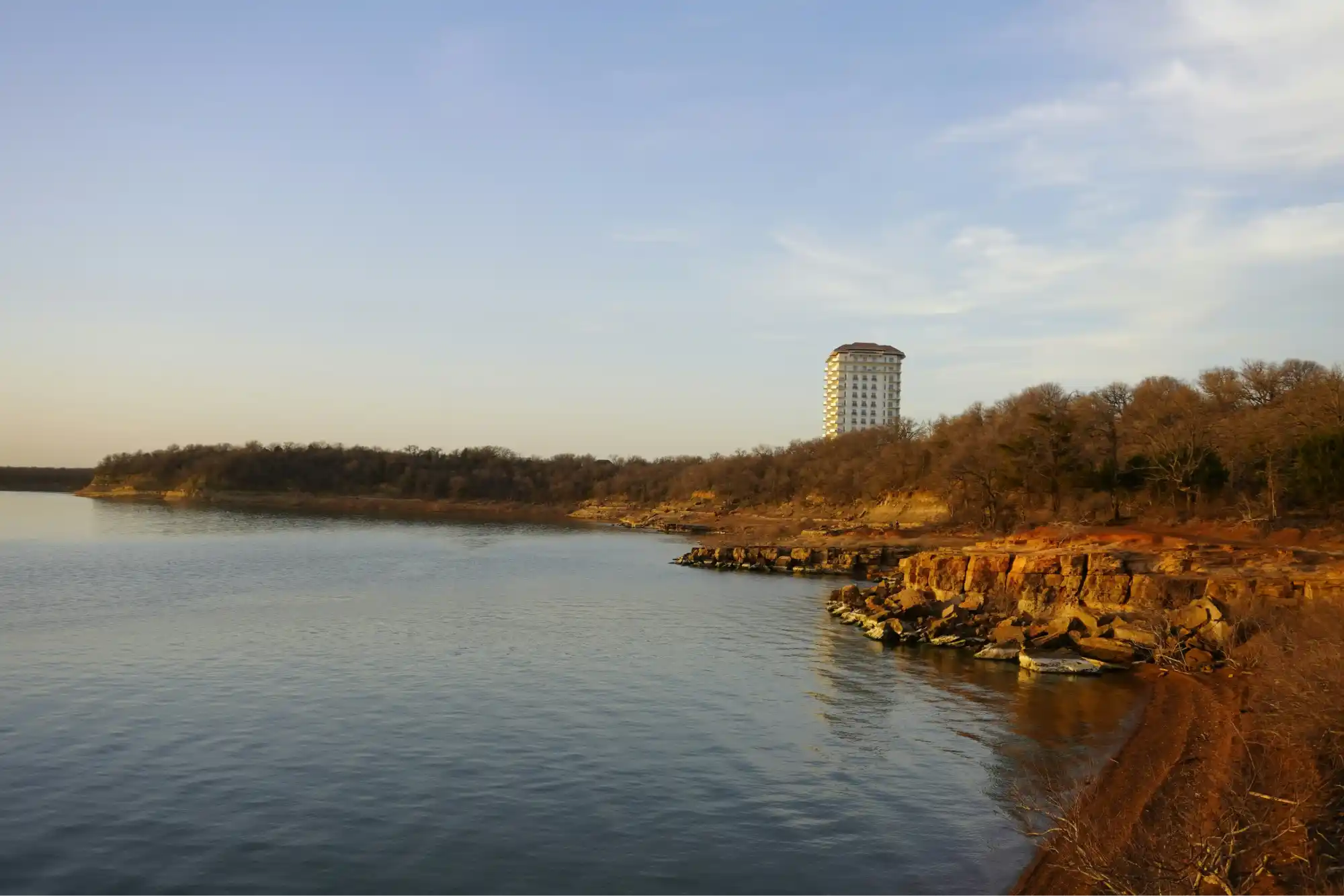
Image Source: Unsplash
Fish species found in the lake include alligator gar, spotted bass, white bass, white crappie, and largemouth bass. Public boat ramps and beaches are available, and Paradise Springs Waterpark offers slides, a lazy river, and a wave pool. Three campgrounds are available for camping. Enjoy the outdoors with family and friends with many activities at Grapevine Lake.
- Skill level: Suitable for beginners to advanced paddlers
- Amenities: Boat ramps, marinas, campgrounds, and fishing docks
- Launch points: Various locations around the lake, such as Meadowmere Park, Oak Grove Park, and Murrell Park
- Fee: None, but some launch points may charge a parking or entrance fee
Note: Check the water levels before heading out. Visit early in the morning or on weekdays to avoid weekend crowds.
3. Lake Arlington
Lake Arlington, located in the southwestern part of the city, is a fantastic paddle boarding Dallas spot with friends or family. The lake is surrounded by gorgeous scenery, and there are multiple beaches where you can stop and take a dip. Lake Arlington is perfect for paddle boarding as it offers stunning views of the city skyline and ample opportunities to spot wildlife.
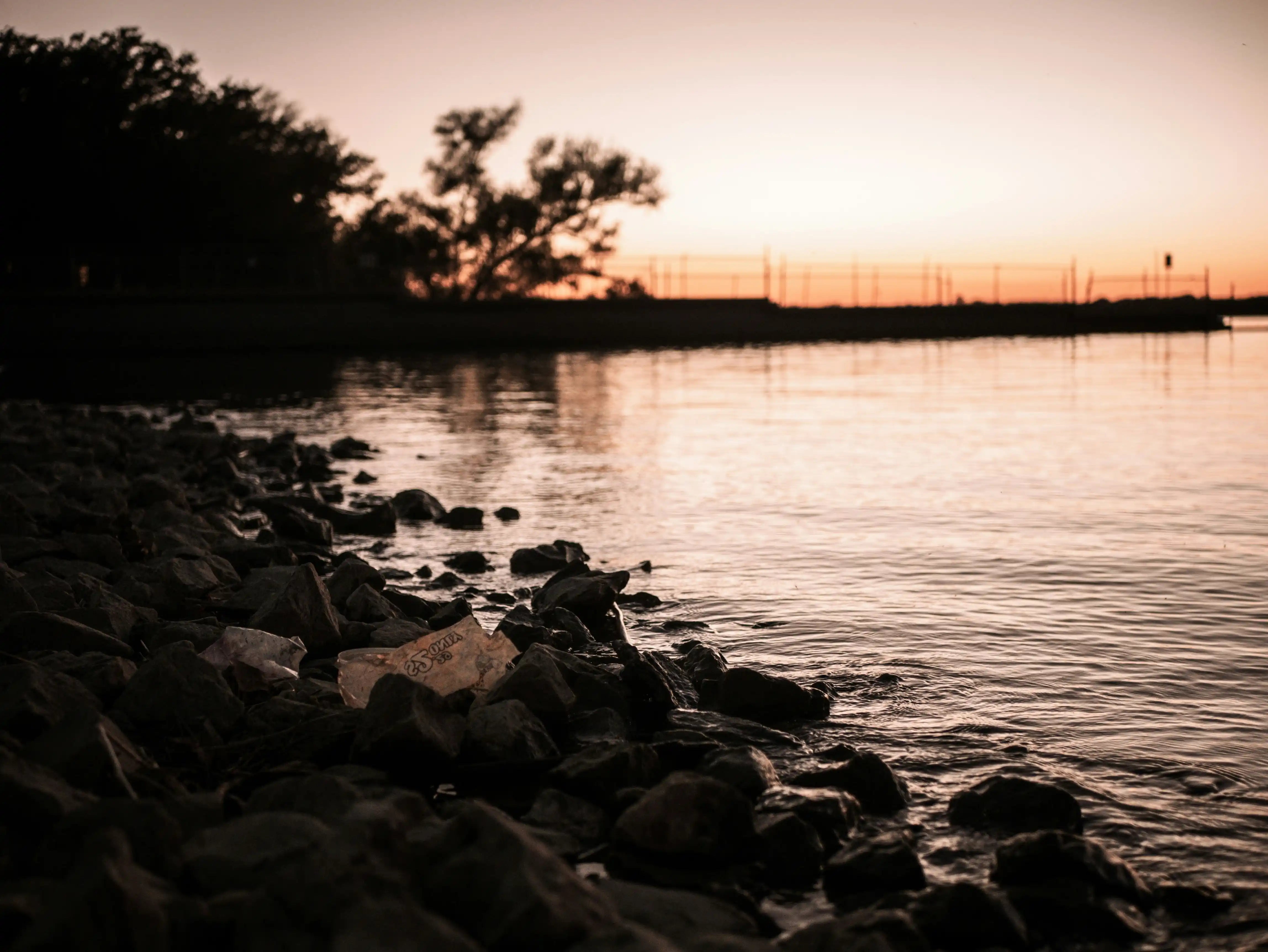
Image Source: Unsplash
The lake has a designated area for paddle boarding, kayaking, and canoeing, where motorized boats are not allowed. This makes it a safe and peaceful place to paddle, especially for beginners. You can also enjoy the views of the surrounding parkland and wildlife, such as ducks, geese, and turtles. Additionally, the lake features a number of paddling trails, making it an ideal place to explore while paddle boarding.
- Skill level: Beginner
- Amenities: Restrooms, picnic areas, playgrounds, fishing pier, boat ramp
- Launch points: Richard Simpson Park and Bowman Springs Park
- Fee: $5 per hour for paddle board rental
Note: Although Lake Arlington is a beautiful place, it's not allowed to swim in because of a series of drownings that have occurred in the lake. As a result, swimmers are not allowed in the water and must stay on the beaches. However, you can bring your own gear to explore this place as there are no rental shops nearby.
4. Elm Fork
About an hour's drive north of the city, you can pick up the Elm Fork of Trinity River after passing Lewisville Lake. This is an excellent location for a weekend day trip if you're looking to get out on the water to paddle boarding Dallas.
Elm Fork is a branch of the Trinity River that flows through the northern part of Dallas, past Lewisville Lake. This is a great spot for a relaxing paddle, as the water is slow, and the banks are shaded by trees. You can spot a variety of wildlife along the way, such as hawks, herons, and deer. You’ll need to bring your own equipment, as paddle board rentals are not available here.
- Skill level: Beginner to intermediate
- Amenities: There are many restrooms, picnic areas, hiking trails, boat ramp around the river
- Launch points: You can launch your board from either Lake Lewisville Dam or Lake Lewisville environmental learning area and paddle for several hours in either direction.
Note: Check the height and flow rate before heading out. Bring your own gear and supplies due to its remote location.
5. West Fork
West Fork is another branch of the Trinity River that flows through the northern part of Texas, traveling towards Fort Worth before reaching Dallas city. Although the water may have a muddy appearance, it is a lively location for fishing paddle board Dallas and a refreshing relief from the hot Texas weather.

Image Source: Flickr
As you move down the river, you can catch glimpses of Fort Worth's skyscrapers and city views along the banks. This spot is ideal for SUP fishing, as the water is rich with fish, such as bass, catfish, and carp. You can also enjoy the views of the city skyline and the bridges as you paddle downstream.
- Skill level: Suitable for intermediate to advanced paddlers
- Amenities: There are public restrooms, picnic areas, pavilion available for everyone
- Launch point: Panther Island Pavilion is one of the most popular places to launch
Note: Rental shops are only available closer to the city. If you want to begin your paddle further upstream and end in the city, you'll need to bring your own equipment.
6. Downtown Dallas
If you want to experience the urban side of paddle boarding, you can head to the downtown section of the Trinity River, where you can paddle under the bridges and skyscrapers of the city. Downtown Dallas is also a great spot for sightseeing, as you can see landmarks such as the Margaret Hunt Hill Bridge, the Dallas Zoo, and the Trinity River Audubon Center.
You will have a great opportunity to enjoy the breathtaking views of Dallas City as you paddle through the downtown areas and under the bridges. After crossing the Loop 12 bridge, you will notice the scenery transform into a dense forest filled with various wildlife species, such as hawks, herons, and storks.
- Skill level: Ideal for intermediate to advanced paddle boarders
- Amenities: Many restrooms, picnic areas, tables, and boat ramps around the river
- Launch point: Trinity River Greenbelt Park
- Fee: $25 per hour for paddle board rental
Note: As always with river paddling, be sure you check the height and flow rate so that you don’t exceed your stand up paddle boarding experience level.
7. Lake Worth
Lake Worth, located in Fort Worth, is a man-made lake that is ideal for paddle boarding Dallas enthusiasts. It was constructed soon after Dallas' White Rock Lake and offers opportunities for fishing, kayaking, and, of course, paddle boarding. Situated on the west fork of the Trinity River, Lake Worth is a reservoir with numerous islands, coves, and channels that make it an excellent place for exploration.
Although you may be in the midst of a concrete jungle, wandering around Lake Worth will make you feel like you are in the wilderness. You will also have the opportunity to spot a diverse range of wildlife, including pelicans, egrets, and beavers. Lake Worth is a habitat for various types of fish, such as white crappie, spotted bass, white bass, and catfish.
- Skill level: Intermediate to advanced levels
- Amenities: Restrooms, picnic areas, camping sites, boat ramps
- Launch points: You can launch your board from any of the public parks or boat ramps around the lake. There are various locations like Casino Beach Park, Lake Worth Park, and Fort Worth Nature Center and Refuge.
Note:
- For beginners, it is safest to stay within the shoreline. Stick to the beachy shoreline for a more gentle paddling session.
- Once you have gained experience, you can explore the entirety of the water.
- Swimming in this place is a challenge due to the murky water.
8. White Rock Lake
Nestled in the vibrant core of Dallas, White Rock Lake is the outdoor paddle boarding Dallas haven, where locals and tourists alike flock to enjoy nature and recreation. The lake is ideal for paddle boarding, as it has calm water, sandy shores, and scenic views.

Image Source: Wikipedia Commons
You can paddle along the 9-mile picturesque shoreline or venture into the coves and inlets, a serene sanctuary amid the city's dynamic pulse. The tranquil waters here are like a breathtaking panorama of the Dallas skyline! You can also see the Dallas Arboretum and Botanical Garden, which is located on the southeast shore of the lake.
- Skill level: Suitable for beginners to advanced paddlers
- Amenities: There are boat ramps, fishing docks, and picnic areas with outdoor activities. These facilities offer a fun and relaxing experience for all.
- Launch points: White Rock Lake Park is one of the most popular places where everyone usually launches.
- Fee: $20 per hour for paddle board rental
Note:
- Pre-book your rental to avoid disappointment.
- Visit early in the morning or on weekdays to avoid weekend crowds.
9. Lake Carolyn
Lake Carolyn is a private lake located in the Irving area in the DFW Metroplex. It is a great paddle boarding Dallas place and explore the city from a new perspective. The lake is calm and clear, making it a great place for a family day out on the water.
You can paddle around the lake or explore the Mandalay Canals, which are modeled after the canals of Venice, and enjoy the views of the urban landscape and the fountains. You can fish for largemouth bass, channel catfish, and common carp while paddling. The lake offers a beautiful view of the Irving skyline and is a relaxing spot to take in the city's sights and sounds
- Skill level: The calm water of this lake makes it perfect for beginners.
- Amenities: There are restrooms, picnic areas, food stores for families, and pavilions for visitors
- Launch point: Lake Carolyn
Note:
- Check the access rules, as Lake Carolyn is a private lake. Perfect for a family day out with the kids on the water.
- Because it’s a private- lake requiring gear rental from outfitters. You should consider heading over to SUP NTX.
- According to a paddler, Sami Hess: "Lake Carolyn does NOT allow people to bring their own paddle boards. I tried. The guy who owns SUPNTX for that lake says that Lake Carolyn prides itself in being the cleanest man-made lake in the metroplex & they don’t want boats that have been in other waters to contaminate their water.”
10. Lake Grapevine
Lake Grapevine is a reservoir located in the northeastern part of the DFW Metroplex, near Grapevine. The lake is a popular paddle boarding Dallas destination and ideal for many water sports, thanks to the recreation, as it has clear water, sandy beaches, and scenic views.
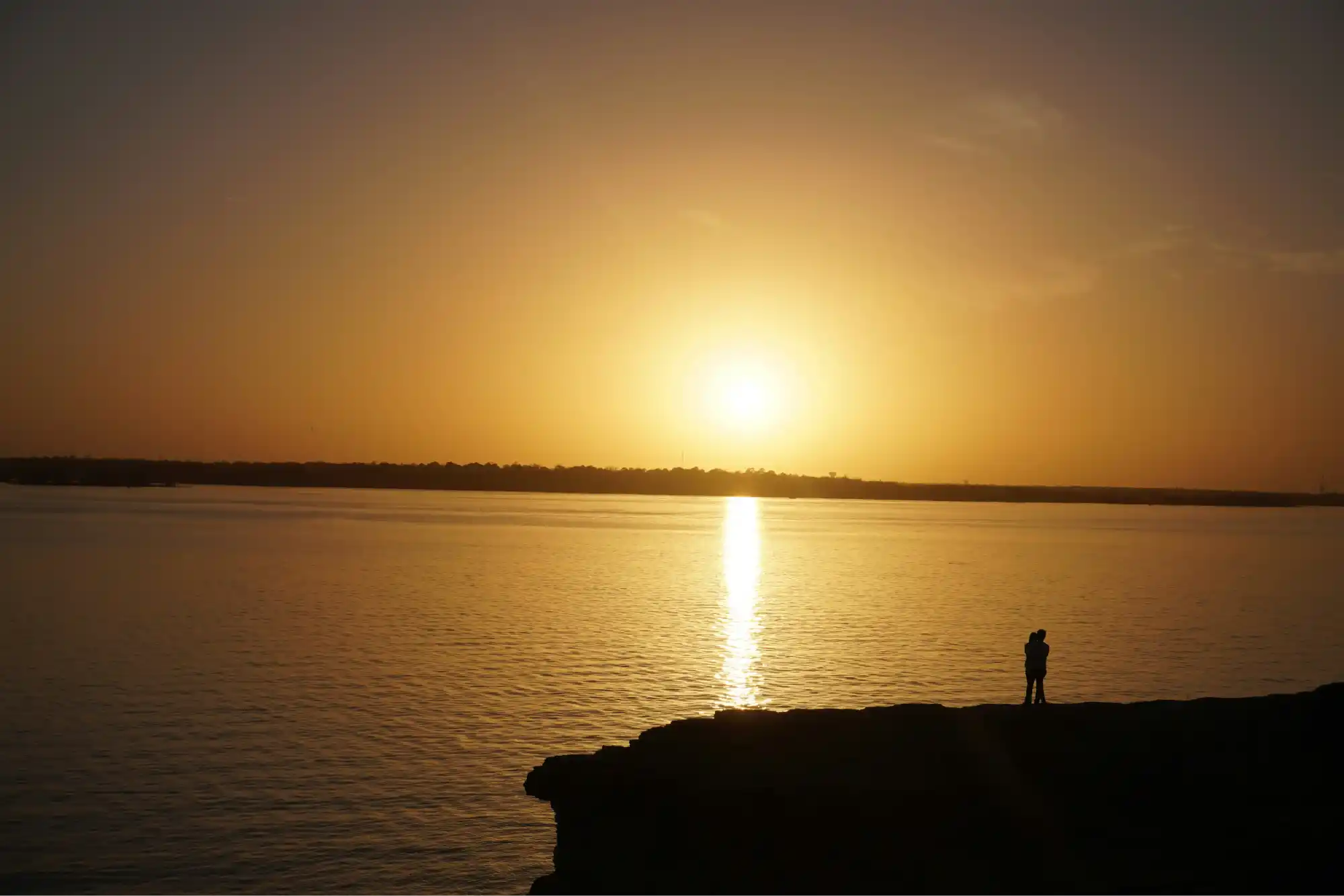
Image Source: Unsplash
You can paddle along the 60-mile shoreline or explore the islands and coves that dot the lake. You can also join a SUP yoga class, a paddle tour, or a sunset paddle with DFW Surf, one of the rental shops near the lake. If you’re feeling adventurous, you can paddle along the Denton Creek.
- Skill level: Beginner to advanced.
- Amenities: Restrooms, showers, picnic areas, camping sites, marinas, and boat ramps are well-maintained for all visitors.
- Launch points: Various locations around the lake, such as Meadowmere Park, Oak Grove Park, and Murrell Park. You can easily access Lake Grapevine from DFW.
- Fee: None, but some launch points may charge a parking or entrance fee.
Note: Visit early in the morning or on weekdays to avoid weekend crowds.
11. Greenbelt Corridor
We then venture into the heart of the Greenbelt Corridor, a serene stretch of the Trinity River nestled between Lake Ray Roberts and Lake Lewisville. The Greenbelt Corridor is a remote section of the Elm Fork of the Trinity River, located in the far northern reaches of Dallas.
This paddle boarding Dallas spot is ideal for a wilderness adventure, as it offers pristine water, lush forest, and abundant wildlife. You can paddle for miles along the slow-flowing river or stop at one of the sandbars or islands for a break. You can also enjoy the hiking trails, equestrian rides, and camping sites along the way.
This verdant haven is a paradise for those who bask in nature's grandeur and a diverse spectacle of wildlife. Dallas paddle boarding is more than a sport—it's about immersing in the journey, connecting with nature, and embracing the thrill of adventure.
- Skill level: Suitable for intermediate to advanced paddlers
- Launch points: Greenbelt Park and Twin Coves Park are convenient locations to launch from.
Note:
- The water is slow-flowing, meaning you can even paddle upstream.
- You’ll need to bring your own equipment, as paddle board rentals are not available here.
12. Brazos River
Brazos River is just a two-hour drive from DFW, making it an ideal place for a proper weekend getaway. The Brazos River, which flows from the New Mexico border to the Gulf of Mexico, is the longest river in Texas. It offers a diverse landscape that includes rolling hills, rocky cliffs, wide floodplains, and sandy beaches, making it perfect for a multi-day paddle trip.
You can also enjoy some SUP fishing as the river is home to various fish species such as bass, catfish, and carp. You can launch your board from any of the public access points along the river or rent one from Brazos River Outfitters, which operates from Possum Kingdom Lake. If you're looking for an exciting adventure, the Brazos River is perfect.
- Skill level: Advanced paddlers. Strong currents and rapids make it a challenging stand-up paddle boarding experience. While navigating its thrilling twists and turns, you can enjoy the breathtaking views of Possum Kingdom Lake.
-
Amenities:
- Well-maintained facilities offer everything you need for a day of fun and relaxation. From restrooms and picnic areas to camping sites and boat ramps…
- The picturesque landscape offers many opportunities to dock and take a mid-paddle break.
- Launch points: You can launch your board from any of the public access points along the river, such as from Possum Kingdom Lake, Lake Granbury, and Lake Whitney.
- Fee: None, but some launch points may charge a parking or entrance fee.
Note: For optimal bird watching, water temperatures, and river levels, you should visit the Brazos River in the Spring.
13. Lake Ray Hubbard
Our grand finale takes us to Lake Ray Hubbard, one of North Texas's largest lakes and a treasure trove for paddle boarding Dallas enthusiasts. Lake Ray Hubbard is a large reservoir located near Rockwall in the eastern part of Dallas.

Image Source: Flickr
The lake is a popular destination for water sports and recreation, as it has clear water, sandy beaches, and scenic views. You can paddle along the 22-mile shoreline or explore the islands and coves that dot the lake. The enthralling view of its expansive horizon, coupled with awe-inspiring sunsets, captivates every adventurer's spirit.
- Skill level: Beginner to advanced paddle boarders
- Amenities: Restrooms, showers, picnic areas, camping sites, marinas, and boat ramps.
- Launch points: Various locations around the lake, such as Terry Park, Windsurf Bay Park, and Dalrock Park. Get an easy access point at Paddle Point Park.
- Fee: Certain launch points may require you to pay a parking or entrance fee.
Can You Paddle Board Year-Round in Dallas?
One of the many perks of paddle boarding in Dallas is the city's year-round accessibility. Courtesy of Dallas' mild winters, paddle boarding is a sport you can enjoy virtually anytime. But, as always, safety first! Be sure to check the local weather conditions before venturing out.
What Should You Wear For Paddle Boarding in Dallas?
Get set to ride the waves! Dress for success with feather-light, fast-drying garb, and toss in a wide-brimmed hat, sunglasses, and some high-SPF sunscreen to keep that Texas sun at bay. No adventurous soul should hit the waters without a trusty Personal Flotation Device (PFD) - safety, after all, is the true thrill-seeker's mantra!

As the mercury dips, slip into a snug wetsuit or drysuit, and pair it with water shoes or sturdy sandals for that perfect grip. Be sure to keep your board tethered with a leash.
Hydration is the adventurer's elixir, so fill your pack to the brim with refreshing water. And who could forget a waterproof bag to safeguard your cherished possessions, some treats for that sudden hunger pang, and your trusty camera to seize the captivating Dallas vistas?
Off you go, paddle in hand, ready to conquer the Dallas waters in style!
Extra Tips for Paddle Boarding in Dallas
- Rent or Buy? If you're just starting out or are visiting, many of these spots offer paddle board rentals. However, if you plan to make paddle boarding a regular hobby, investing in a high-quality paddle board like an iROCKER is the way to go.
- Safety First: Always let someone know where you’re going and when you expect to return. Even experienced paddle boarders can encounter unexpected situations.
- Respect Nature: While enjoying the beauty of these Dallas waterways, remember to respect the environment. Avoid disturbing wildlife and always leave the place as clean as you found it.
Paddle Boarding Dallas: Let’s go!
So, are you ready to embark on your paddle boarding Dallas journey? With iROCKER, you'll explore diverse waterways and connect with nature like never before. Don't just ride the waves, make unforgettable memories! Join us, and let's make a splash together in the Dallas waters.

There’s a whole world of possibilities to explore the water, stay fit, and enjoy thrilling moments on your paddle board. As this exhilarating sport continues to attract enthusiasts, heavier paddlers can confidently join the fun, thanks to the availability of high weight capacity paddle boards. Let’s discuss the weight limits for paddle boarding, guide you through selecting the perfect high weight capacity paddle boards, and highlight the best options for paddlers of all sizes to ensure a positive experience.
How Will You Use Your SUP?
A paddle board's weight capacity relies on its overall volume, determined by factors such as length, width, and thickness. Generally, larger boards with greater volume can accommodate more weight.
To identify the ideal paddle board size for you, consider both your weight and the activities you want to pursue, including leisure paddling, yoga, or racing. The following table illustrates the correlation between paddle board volume and maximum weight capacity, helping you choose the suitable paddle board:
| Rider Weight Range (lbs) | Board Volume (Liters) | Board Length (Feet) | Board Width (Inches) | Board Thickness (Inches) | Approx. Weight Limit (lbs) |
|---|---|---|---|---|---|
| Under 150 | 150 - 175 | 9'6" - 10'6" | 29" - 32" | 4" - 5" | Up to 200 |
| 150 - 200 | 176 - 200 | 10' - 11' | 30" - 32" | 4.5" - 5.5" | Up to 250 |
| 200 - 250 | 201 - 225 | 10'6" - 12' | 31" - 33" | 5" - 6" | Up to 300 |
| 250 - 300 | 226 - 250 | 11' - 12'6" | 32" - 34" | 5.5" - 6.5" | Up to 350 |
| Over 300 | 251 - 300+ | 12' - 14' | 33" - 36" | 6" - 6.5" | 350+ |
5 Best Paddle Boards For Heavy Paddlers
Here are some of the top paddle boards from iROCKER for heavy paddlers, each offering high weight capacities and robust construction:
1. BLACKFIN MODEL V
For heavy paddlers, the BLACKFIN Model V is a fantastic option with a 485lbs weight capacity. The 12'6" long board features a 32” width and triple-layer, military-grade PVC construction. As an inflatable stand up paddle board, it adeptly balances high-performance expectations with the capability to carry significant loads, making it an ideal choice for multi-day adventures, fishing expeditions, and SUP yoga.
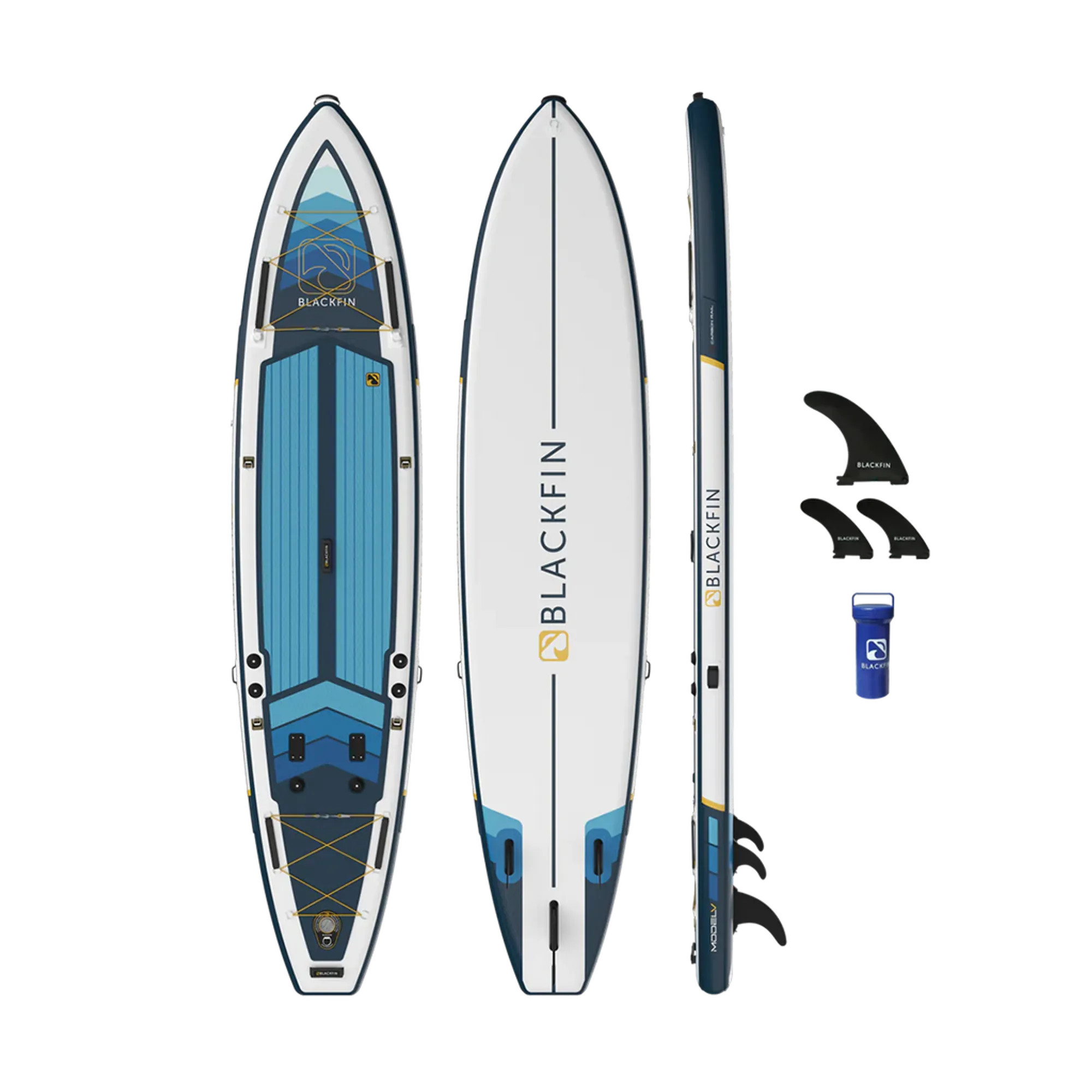
With triple-layer composite construction and a built-in carbon rail, the board demonstrates unparalleled rigidity and durability. Such construction assures that the board can support up to a 485-pound load without sacrificing performance. Whether loaded with gear for an overnight trip or navigating long distances, the Model V remains steadfast and agile.
Its 6-inch thickness further elevates the board's buoyancy and rigidity, even under full load.
Versatility shines as a significant attribute of the BLACKFIN Model V, with ample cargo space, action mounts, and D-rings, for seamless customization for any adventure requirements. From securing fishing gear and coolers to attaching a kayak seat for enhanced paddling comfort, the possibilities are expansive. The deck pad, crafted from grooved and logo-embossed EVA foam, ensures superior traction and comfort for extended journeys.
2. iROCKER CRUISER 10'6"
Introducing the iROCKER CRUISER 10'6" – an exceptional choice for heavy paddlers, boasting a 400lbs weight capacity. With its 33” width for stability and robust, triple layer PVC construction, the CRUISER delivers unparalleled durability and performance. Ideal for leisure paddling, yoga, and fishing, this board beckons you to enjoy the water like never before.
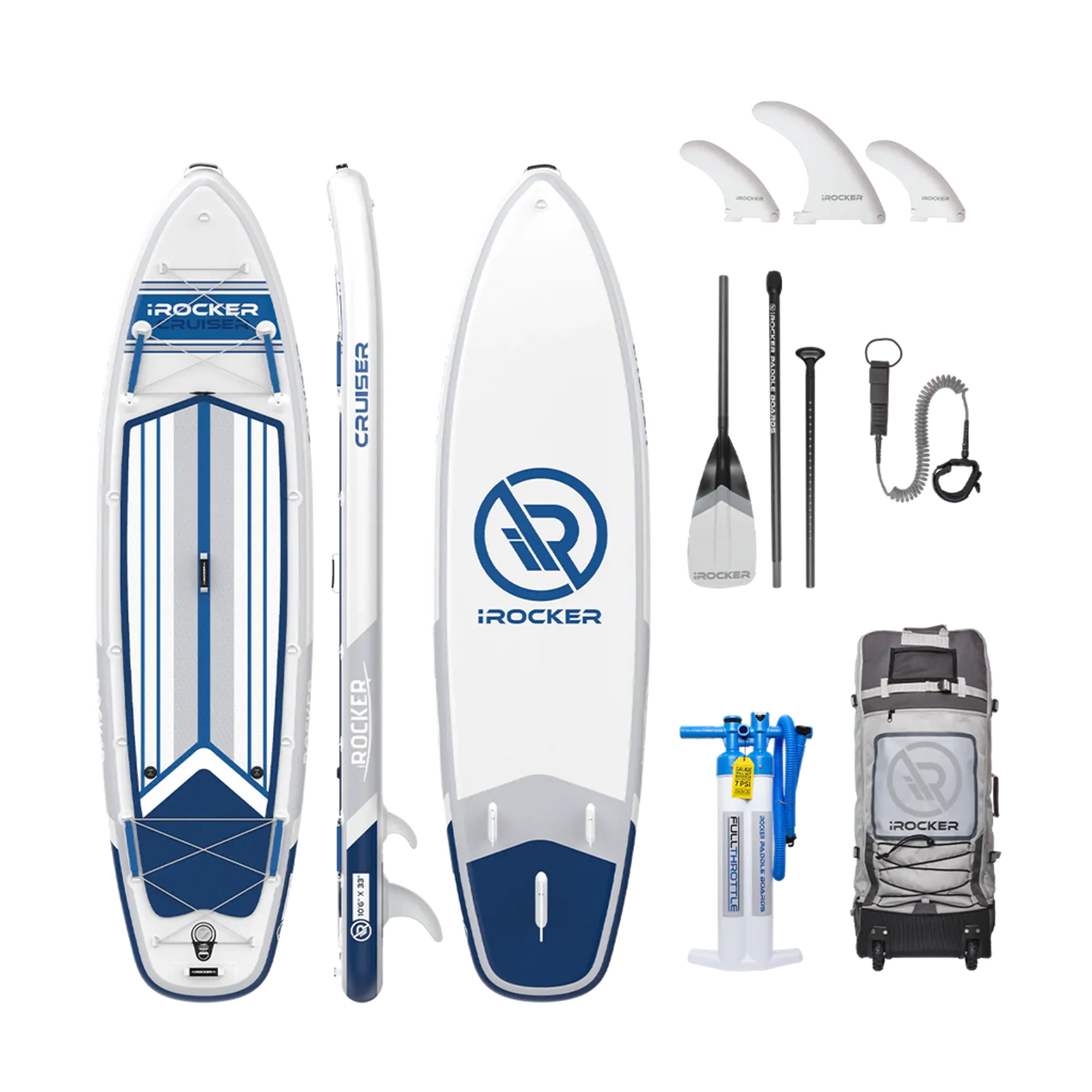
Stability is where the CRUISER truly shines. At a width of 33 inches, it offers a stable base that's ideal for a range of activities—from SUP yoga to adventurous outings loaded with gear, or simply enjoying a day on the water with pets or young ones. The board's design ensures it glides smoothly and maintains good tracking across various water conditions. Whether you're paddling on a peaceful lake, navigating the gentle currents of a river, facing the open sea, or catching small waves, the CRUISER adapts effortlessly to your surroundings. Its impressive capacity to support up to 400 lbs makes it a standout choice for paddlers who like to bring along extra gear or companions, providing a versatile platform for any aquatic adventure.
The iROCKER CRUISER 10'6" is built to withstand the test of time, crafted from high-quality materials and accompanied by all the essentials you need to start paddling. All high weight capacity paddle boards are designed with families and pets in mind, featuring safety side handles for secure paddling with children and numerous mounts and D-rings for convenient gear attachment, ensuring a seamless experience for paddlers at all levels.
If you're looking for something a bit larger, the BLACKFIN Model XL is a great choice. It adds an extra foot in length while slightly narrowing down to 34 inches in width.
3. BLACKFIN MODEL X
Give your attention to the BLACKFIN Model X if you’re feeling adventurous but love extra stability. This board can shoulder 450lbs while ensuring a steady platform with its generous 35” width. It is crafted with triple-layer PVC and measures 10’6” in length, guaranteeing a full spectrum of experience whether you're touring, fishing, or just having family fun. The stiffness and durability are enhanced by the built-in carbon rail, ensuring the board performs well in different types of water conditions.
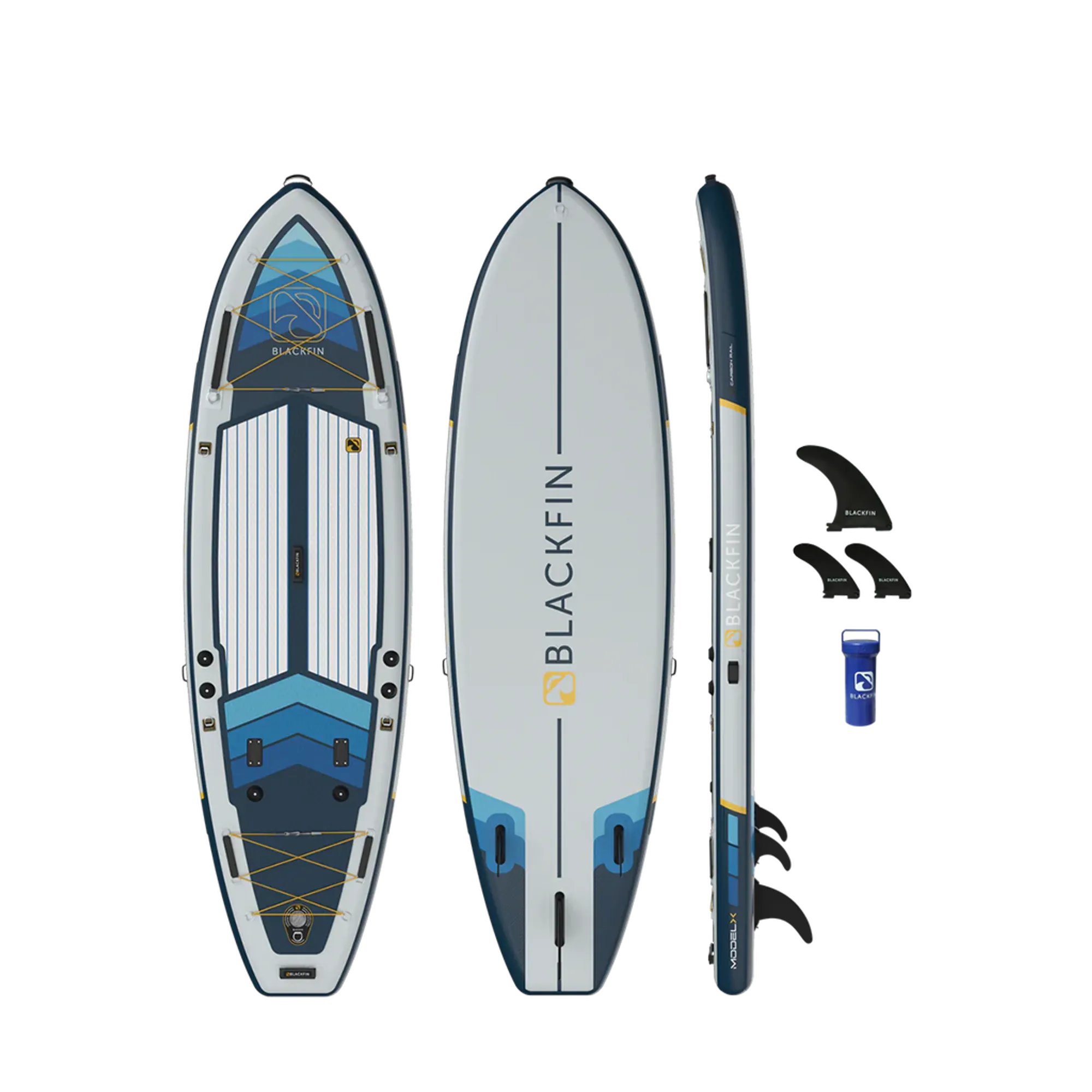
One of the great things about the Model XL is its versatility. It has many useful features like D-rings and action mounts, which make it easy to customize for various activities. Whether you're attaching a kayak seat, securing fishing gear, or carrying extra equipment, this board can handle it. It also has plenty of storage space, which is perfect for longer trips or when you have lots of gear.
Despite its large size, the Model XL is easy to maneuver. This makes it a great option whether you're a beginner or an experienced paddler. Its ease of handling ensures that you'll have a good time on the water, no matter what you're doing.
Venture forth and conquer those waves with the BLACKFIN Model X!
4. BLACKFIN MODEL XL
Are you seeking high weight capacity paddle boards? Look no further than the BLACKFIN Model XL. With a 485lbs weight capacity and a 35-inch width, this board offers a perfect blend of stability and performance. The triple-layer PVC construction ensures longevity; whether you’re an angler, cruiser, a parent paddling with kids or pets, a yoga enthusiast, or someone gearing up for a paddling expedition, the ample dimensions make it ideal for diving into endless possibilities!
The Model XL combines a wide stance with a long waterline, striking a perfect balance between stability and speed. iROCKER focuses on every detail of the construction process, adding reinforced seams and upgraded internal rail construction, delivering high durability and rigidity. This meticulous construction allows the board to support heavy loads without losing performance.
Flexibility is at the core of the BLACKFIN Model XL's design, offering customizable storage options such as adjustable bungee cords and various mounting points to support a wide range of accessories.
5. iROCKER ALL AROUND 11’
The iROCKER ALL AROUND 11’ distinguishes itself as an excellent choice among high weight capacity paddle boards. It's specifically designed for taller individuals over 5’8”. It is perfect for those who frequently carry extra items like fishing gear, camping supplies, or even pets and children on their aquatic adventures.
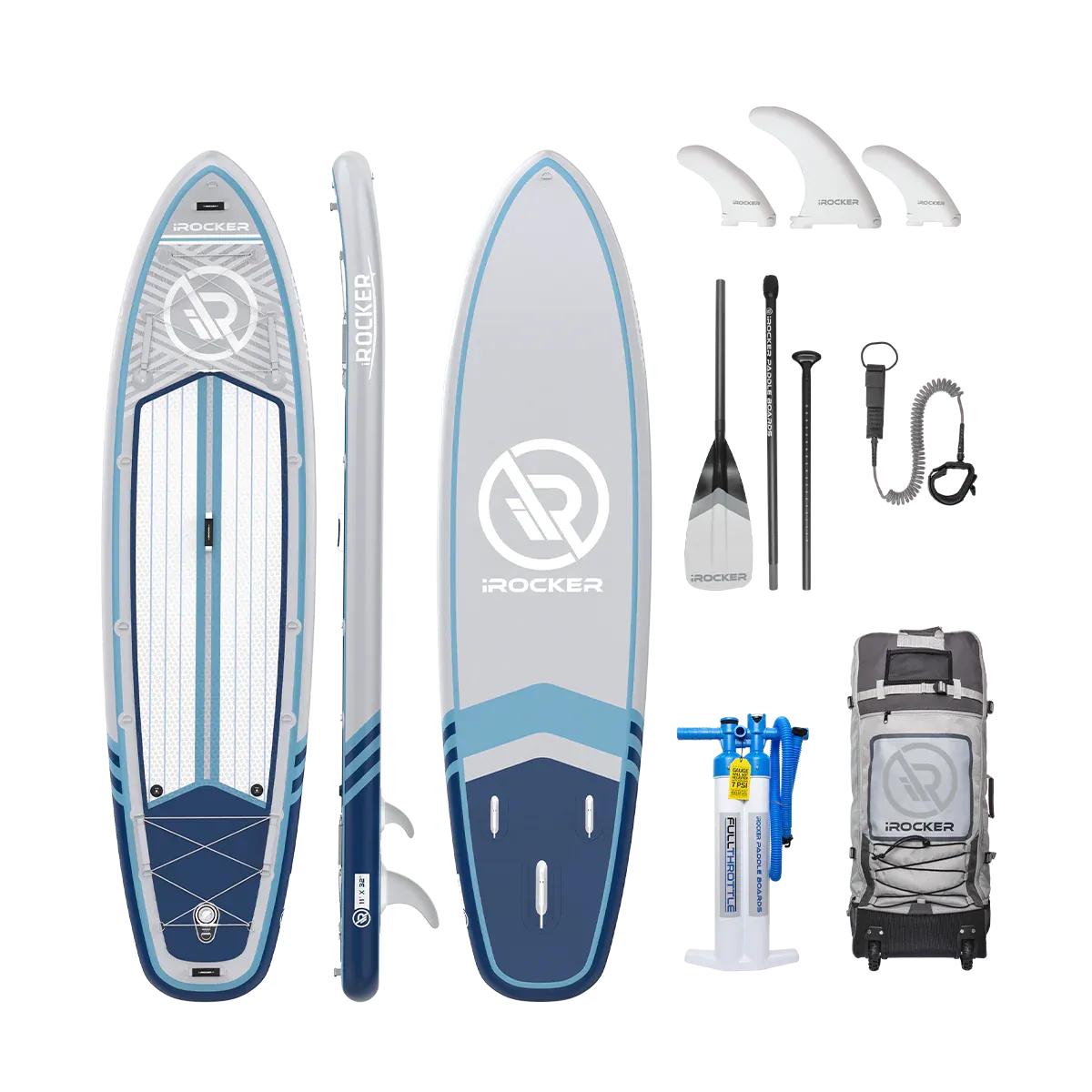
Its robust construction, with a triple-layer composite build similar to the ALL AROUND 10’ and iROCKER CRUISER, is a highlight that ensures durability. The core of the board uses a drop stitch construction with knitted polyester fabric, creating a 6-inch thick, stable platform when inflated.
The iROCKER ALL AROUND 11’ comes with a triple fin setup that significantly boosts its performance. With this design, paddlers can easily adjust the board's tracking and maneuverability to match diverse water conditions and suit their individual preferences.
The inclusion of a lightweight carbon fiber/nylon paddle and a triple action hand pump adds to the board's ease of use and quick inflation.
Choose the Right High Weight Capacity Paddle Board for Your Needs
As a heavier paddler, it's essential to select a paddle board that offers both a high weight capacity and the stability and performance you require. When searching for the perfect high weight capacity paddle boards, consider these expert tips:

- Volume: As previously emphasized, a paddle board's overall volume determines its weight capacity. Choose a board with a volume that aligns with your weight for optimal support.
- Width: Stability is crucial for heavy paddlers, and wider boards generally deliver this much-needed attribute. Target a board with a minimum width of 32 inches.
- Length: When selecting a paddle board, consider the activities you plan to engage in. For casual recreational use, boards ranging from 10'4" to about 11'6" in length are suitable. However, if your goal is to achieve exceptional speed and tracking, opt for a longer board, specifically between 12'6" and 14'. For paddle board yoga, a length of 10'6" to 11'6" is recommended to have a stable and spacious platform for your practice.
- Thickness: The build of your paddle board significantly impacts its ability to carry weight and maintain shape, particularly for inflatable options. A thickness of 6 inches is generally optimal for inflatable paddle boards with a balance between buoyancy and stability. For solid SUPs, a thickness ranging from 4.5 to 5 inches is ideal.
- Construction: Robust materials are critical for standup paddle board accommodating heavy paddlers, as more strain may be exerted on the board. Seek out boards crafted from durable materials such as military-grade PVC and featuring multi-layer construction for long-lasting performance.
Paddle boarding is a fantastic way for paddlers of all sizes to enjoy the outdoors, stay fit, and explore the water. Getting the right capacity paddle board is one of the most important components for any paddler. The right paddle board can take you places and elevate your water escapades. Unleash your inner adventurer with the perfect high-capacity paddle board from iROCKER and conquer the waves today!

Ahoy, fellow adventurers and dog lovers! If you're seeking to combine your love for stand-up paddle boarding (SUP) with your fondness for your furry friends, then you've come to the right place. Let’s explore the top dog-friendly SUP boards for you and your canine companion. Get ready to make a splash with your pup and embark on some unforgettable adventures together!
Can You Bring Your Dog on Board with You?
For experienced paddle boarders and dog enthusiasts, rest assured that taking your furry companion along for a SUP ride is definitely achievable. As one of the leading SUP manufacturers, iROCKER guarantees that our paddle boards can handle dogs' nails without popping. With a variety of suitable boards to choose from, you and your pup can enjoy the open water together anytime you want.

Key Features of Dog-Friendly SUP Boards
When embarking on a SUP expedition with your furry friend, there are several vital features to take into account. Let's dive into the key elements that'll make your paddle board shipshape for your canine companion.
Stability
Steady as she goes! Stability is the backbone of any dog-friendly SUP board. A broader board ensures a firmer footing for you and your trusty sidekick, minimizing the chances of unexpected plunges into the briny deep. Set your sights on boards with a width of at least 32 inches and a thickness of 6 inches for smooth sailing with your beloved pup.
Traction Pads
A good traction pad is essential for your dog's comfort and safety on the board. The pad should be soft and grippy, allowing your pup to maintain their footing while you paddle. Opt for boards with full-length traction pads, or consider adding an aftermarket pad designed specifically for dogs.
Deck Space
Ample deck space is another key feature for a dog-friendly SUP board. Make sure that there's enough room for your dog to sit or stand comfortably without hindering your paddling or balance. Generally, a board that's 10 to 12 feet long should provide enough space for both you and your canine companion.
Durability
Last but not least, durability is paramount. A dog paddle board should be built with high-quality materials, such as military-grade PVC, to withstand your dog's nails and the rigors of regular use. Inflatable boards are a popular choice, as they offer a high degree of durability and resistance to punctures.
Top Dog-Friendly SUP Boards on the Market
Now that we've covered the essential features, let's dive into the top dog-friendly SUP boards that will help you and your pup have a tail-wagging good time on the water.
BLACKFIN MODEL XL
The BLACKFIN MODEL XL ensures a fun and safe experience on the water. With its 34" width and 11'6" length, this board provides ample space and stability for you and your four-legged friend. Constructed with military-grade PVC, it's designed to handle any adventure you embark on. Plus, the soft deck pad offers a secure grip for your pup's paws, making it the ideal choice for a dog paddle boarding excursion.

iROCKER Cruiser 10'6
Introducing the iROCKER Cruiser 10'6 - the ultimate dog-friendly paddle board for both new explorers and seasoned seafarers alike! Its wide and stable design makes it perfect for all skill levels, while the spacious deck and full-length traction pad help your trusty canine stay comfortable and safe. So, hoist the mainsail and embark on a thrilling aquatic adventure with your beloved pup by your side.

iROCKER CRUISER ULTRA™
The iROCKER CRUISER ULTRA™ is a top-notch choice for paddle boarding with your dog. At 33" wide and 10'6" long, this board provides exceptional stability and abundant room for you and your furry companion to enjoy together. Made from military-grade PVC, this board is built to withstand your adventurous outings. The comfortable deck pad ensures a secure and cozy surface for your dog to enjoy the ride.

BLACKFIN MODEL X
Next up, we have the BLACKFIN MODEL X. This premium inflatable SUP board is a true champion for dog lovers everywhere. With an extra-wide deck and carbon-reinforced construction, it's built to handle even the most spirited canine sailor. Use the dual cargo storage areas to stash all your gear (and treats!) for a full day of adventure. Plus, the ultra-comfortable deck pad provides extra grip for your four-legged friend.

Board Accessories for Paddling with Your Dog
To ensure your paddle boarding adventures with your pooch go swimmingly, here are some essential accessories to consider:
Dog Life Jackets
First and foremost, safety is paramount for you and your furry first mate. Equip your dog with a well-fitting life jacket to keep them afloat and visible. Look for options with grab handles for easy lifting and bright colors to increase visibility.
Leashes
A trusty leash is a must-have for any dog-paddling duo. Choose a coiled SUP leash that connects to your board and your dog's life jacket. This way, you can keep your dog close by, and the coil will prevent any unnecessary tangles.

Board Carry Straps
Transporting your SUP board to and from the water can be a breeze with the right carry straps. Adjustable straps with padded shoulder support will make it easy for you and your dog to navigate the journey to your next adventure.
Waterproof Gear Bags
Safeguard your precious cargo with trusty waterproof gear bags. Ideal for stowing treats, and other essentials, these bags secure smooth sailing and great times on the high seas with your furry buddy.
Making Waves Together with iROCKER SUP
For spirited, seasoned adventurers who adore dogs, the joy and camaraderie of sharing SUP experiences with a four-legged companion cannot be overstated. The listed paddle boards above are top-notch dog friendly SUP boards that, along with the right accessories, will give you and your dog the time of your life out on the water.
So, what are you waiting for? Grab your paddle, puppy friend, and set sail for a world of adventure with iROCKER SUP. Happy paddling!

Picture this, you're out on the water, soaking up the sun, and laughing with your best pal as you both paddle your way through an aquatic adventure. Sounds like a dream, right? A 2-person paddle board can turn that dream into a reality. Learn more about a 2-person paddle board, key features to look for, and some top models to check out right here.
Why Should You Buy A 2-Person Paddle Board?
A 2-person paddle board is a fantastic investment for several reasons:
- Shared Adventure: What's better than embarking on an exciting SUP excursion? Doing it with a friend, of course! A 2-person paddle board allows you to share the experience, making it twice as enjoyable.
- Learning Together: If you're new to paddle boarding, learning with a partner can help you both improve your skills faster, as you can provide each other with tips, support, and encouragement.
- Fitness and Fun: Paddle boarding is a full-body workout that's also a blast to do. With a 2-person board, you can challenge each other and make your workouts more engaging and enjoyable.
- Versatility: These boards are designed to accommodate two people but can also be used solo, giving you the flexibility to paddle alone or with a partner.
Key Features to Look For When Choosing A 2-Person Paddle Board
There are several features to consider before you hit that “Add to Cart” button to ensure you're getting the perfect 2-person paddle board for your needs:
Stability
A stable board is the key to an enjoyable time on the water. Seek a board that's wide enough to provide optimal stability so you and your paddling partner can steady your sea legs while you explore the great blue.
Weight Capacity
You'll need a paddle board that can support the combined weight of you and your fellow adventurer, as well as any treasure or gear you plunder along the way. Most 2-person paddle boards support around 450lbs, but keep a keen eye on board specifications to ensure you're purchasing a SUP that will support your needs.
Maneuverability
Though a larger vessel offers more stability, steering can be a challenge. Look for a board that balances stability and maneuverability, so you can deftly navigate turns.
Accessories
Keep an eye out for boards equipped with useful accessories like dual paddles, a pump, and a carrying bag. These add-ons will enhance your SUP escapades, making them as smooth sailing as a calm day at sea, all while maintaining a professional touch.
Top 2-Person Paddle Board Models For You
Ready to make a splash with your new 2-person paddle board? Check out these top models that are perfect to double the fun:
BLACKFIN MODEL XL
The BLACKFIN Model XL is the best of SUPs, offering exceptional stability for tandem paddling. Its military-grade construction ensures durability, while the 485lbs weight capacity lets the two of you glide through the water with ease. If you're into long, leisurely paddles, fishing, or SUP yoga, it is your floating oasis.

BLACKFIN MODEL V
The BLACKFIN MODEL V is perfect for couples and adventurers who crave distance and speed. Made with triple-layer PVC composite and slim in design, the board glides through choppy waves like a knife through butter. It is also perfect for touring and exploring, making every SUP session an epic expedition.

BLACKFIN MODEL X
The BLACKFIN MODEL X is suitable for both beginners and experts. The design is extra focused on stability, with a wider base that provides comfortable room for both riders. The material is similar, triple layer PVC composite, but with an added carbon rail for supreme rigidity. Whether you're navigating calm lakes, tackling ocean swells, or trying out SUP fitness, the Model X adapts and excels.

iROCKER CRUISER
The iROCKER Cruiser features a sleek design with all the functions of a board for two. It features a wide base, moderate tail, and is made of triple-layer military-grade PVC with a drop-stitch core for smooth and steady rides. The Cruiser invites you to soak up the sun, enjoy the view, and enjoy the ride at your own pace.

Dive Into Another World of Paddle Boarding with iROCKER!
A 2-person paddle board is the ultimate way to double the fun of stand-up paddle boarding. If you are looking for a 2-person board to upgrade the fun with your buddy, look no further than iROCKER’s extensive collection. With several fantastic models to choose from, you and your adventure partner will be well-equipped for a day of aquatic exploration. Embrace the fun vibes and make a splash together!

Paddle boarding has surged in popularity, captivating countless water lovers. Among the exciting activities to explore on a paddle board, fishing has hooked outdoor enthusiasts. Dive into this guide as we navigate the thrilling realm of fishing paddle boards, unveil must-have gear, and reveal tips and tricks to help you catch that trophy fish – all while having a blast on your board!
Can You Fish From A SUP?
Yes, you absolutely can! Stand-up paddle boards (SUPs) have evolved into versatile watercraft, allowing anglers to access hard-to-reach fishing spots and enjoy a unique, immersive experience. Fishing from a paddle board offers the advantages of stealth, mobility, and a higher vantage point, which can be particularly useful when sight fishing. However, not all paddle boards are created equal, so choosing the right board for your fishing adventures is important.
Features To Look For In A Fishing Paddle Board
Width
Stability is key for fishing on a paddle board, so choose a SUP with sufficient width. Wider boards offer a stable platform, easing casting and reeling. Opt for a board at least 32 inches wide for optimal stability and maneuverability.
Add-Ons
Enhance your fishing experience with built-in or compatible add-ons, like fishing rod holders, tackle compartments, and cooler tie-downs. These keep your gear organized and accessible, allowing you to focus on catching fish.
Portable Design
An inflatable paddle board is a great choice for SUP fishing as its portable design allows you to throw it in the car—or boat—and head to the day’s fishing spot. Simply inflate, fish, and deflate when you’re ready to head home.

Essential Gear and Accessories For Paddle Board Fishing
Prior to venturing onto the water, make sure you're equipped with the essential gear and accessories for a safe and enjoyable fishing experience. Some key items include:
- Personal flotation device (PFD): Prioritize safety with a PFD, a crucial piece of equipment for any water-based activity.
- Paddle and leash: A high-quality paddle enhances your paddling experience, and a leash prevents your board from drifting away should you take an unexpected dip.
- Anchor: This will help you stay in one spot while fishing, especially in an area with strong currents or winds.
- Fishing gear: Make sure you have your fishing rod, tackle, bait, and other equipment on hand before heading out.

Tips and Techniques For Paddle Board Fishing
Casting and Reeling Techniques
When fishing from a paddle board, it's essential to use smooth, controlled casting movements to maintain your balance. Keep your feet shoulder-width apart and bend your knees slightly for stability. Practice sidearm or underhand casting techniques to help you avoid snagging your line on the board or paddle.
Maintaining Balance and Stability
Maintaining balance is crucial for a successful paddle board fishing trip. Start by positioning yourself in the center of the board, with your feet parallel to the rails. Keep your knees slightly bent and engage your core muscles for added stability. When reeling in a fish, maintain a low center of gravity by squatting down and using your legs for support.

Approaching and Catching Fish
Stealth is your best friend when paddle board fishing. Approach your target area quietly by using gentle paddle strokes and minimizing splashing. Once positioned, use an anchor to stay put. Be patient and let the fish approach.
Safety Considerations and Best Practices
Prioritize safety while on the water. Check weather conditions, know the area, wear a personal flotation device (PFD), and bring a whistle or signaling device for emergencies. Additionally, inform someone of your planned route and expected return time.
Check out our Fishing collection now!

Where to Find the Best Fishing Paddle Board?
A successful paddle board fishing experience starts with the right equipment. If you're looking for a top-quality paddle board, consider iROCKER. Our BLACKFIN boards are designed with anglers in mind, featuring ample width for stability, built-in or compatible add-ons like rod holders and fishing racks, and durable construction that can withstand the rigors of fishing. With the right gear and these helpful tips, you'll be well on your way to reeling in the big one while enjoying the great outdoors. Happy fishing!

Are you ready to live your best life on the water? Stand up paddle boarding and kayaking are both popular water sports that offer limitless enjoyment and discovery. But which to choose? Let’s dig in.
| FEATURE | PADDLE BOARD | KAYAK |
|---|---|---|
| Stability | Excellent stability for calm waters and good for beginners | Stable in various water conditions, including rough water |
| Size | Generally smaller and lighter than kayaks | Larger and heavier than paddle boards |
| Portability | Easy to transport, inflatable options available | Less portable, requires roof racks or trailer |
| Durability | Durable construction, even for inflatable models | Rugged, hard-shell materials provide added durability |
| Gear Storage | Limited storage, but attachments available for most boards | Ample storage in hatches and on deck |
| Fitness | Excellent full-body workout, engages core muscles | Focuses on upper body and cardio fitness |
| Price | Wide price range, generally more affordable | Wider price range, some models can be expensive |
Paddle Board vs Kayak: Which is Easier?
Both kayaking and paddle boarding offer exciting challenges, each presenting a unique learning curve.
So, is paddleboarding easy? Most novices can swiftly conquer balance and maneuvering on a stand up paddle board in just a few hours. And the longer you spend on your board, the more comfortable you’ll become. Start out on calm waters and work your way up to longer and more challenging paddle sessions, and even take on some exhilarating ocean waves.
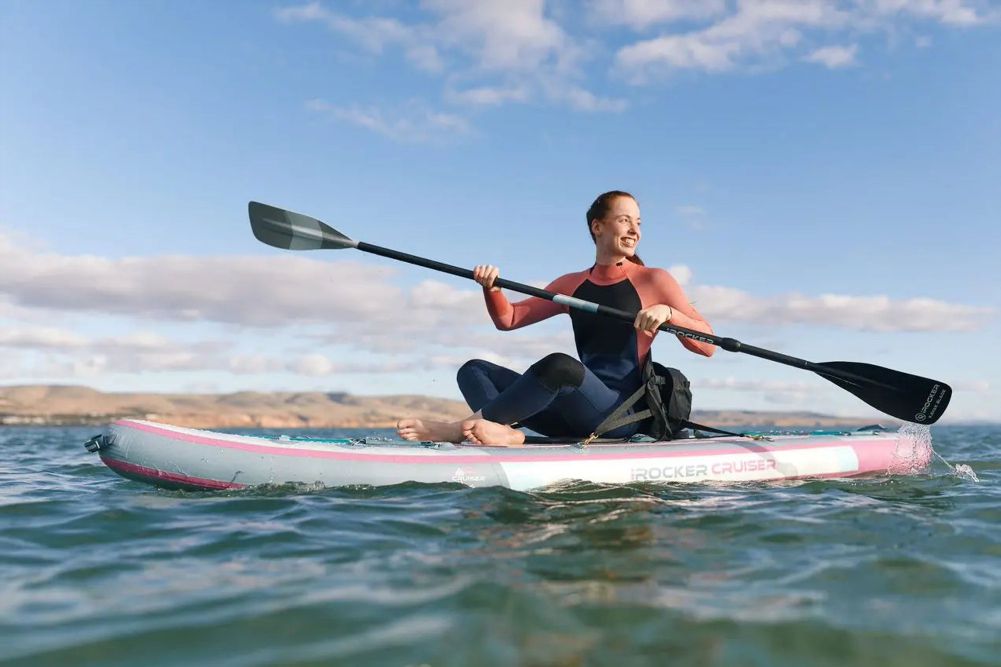
Similarly, kayaking beginners can master paddling in a matter of hours, all while remaining comfortably seated on the water. This makes it a less physically taxing pursuit on the lower body but it can be a great upper body workout, especially if paddling hard or against a current.
What’s the Better Option?
Selecting the perfect watercraft for your on-the-water adventure is crucial, and understanding your individual preferences and needs will guide you towards the right choice.
Stand up paddle boarding delivers a distinctive experience that not only engages your core muscles for a full-body workout, but also allows you to appreciate the stunning scenery around you. In contrast, kayaking provides stability and comfort for extended journeys, making it easy to cover long distances and navigate various water conditions.
1. Fitness
SUP shines as a top workout choice with a low-impact, full-body workout that tones muscles and burns calories. It's an effective way to get in shape since it works everything from your legs to your core and upper body.
Meanwhile, kayaking also provides a solid workout, primarily focusing on your upper body. Your fitness goals determine the best fit, but for an all-around stabilizer muscle workout, SUP takes the lead.
2. Stability
When we talk about stability on the water, kayaks edge out slightly ahead due to their lower center of gravity, making them inherently more stable, especially for those just starting out.
With SUP, you're standing up, which naturally challenges your balance more. But don't let this deter you – it's precisely this standing position that attracts many to paddle boarding in the first place. It adds an element of challenge and fun that's hard to beat.
3. Getting Back On
As for reboarding after a tumble, SUPs are notably more user-friendly in this aspect. Their open and flat design allows for effortless climbing back on board. Even if you fall off, the board stays nearby, thanks to the use of a leash.
In contrast, kayaks present a bit more of a challenge. If your kayak capsizes, you first need to flip it over, which can be a daunting task, especially in deep waters. Then, getting back into the kayak requires some practice and skill, balancing yourself to avoid another capsize.
4. On-Board Storage
When comparing on-board storage, kayaks generally offer more advantages. Kayaks are equipped with designated storage spaces, ideal for longer trips or when you need to carry equipment like cameras, fishing gear, or picnic supplies. The storage areas in kayaks are designed to keep your belongings relatively dry and are easily accessible while you're on the water.
Paddle boards, on the other hand, provide a different storage dynamic. They come with limited deck space where you can secure your gear. However, managing this space is crucial as it impacts your ability to maneuver the board. Any gear on a SUP is also exposed to elements, necessitating waterproof containers for protection. While SUPs can carry a decent amount of gear, accessing it mid-paddle can be more cumbersome than with a kayak.
5. Transport and Portability
In terms of transport and portability, paddle boards often have an edge over kayaks, particularly when considering inflatable models. Inflatable SUPs are lightweight and can be easily packed into a carrying bag, making them a breeze to transport and store. This portability is a significant advantage for those with limited storage space or for adventurers who like to take their board on travels.
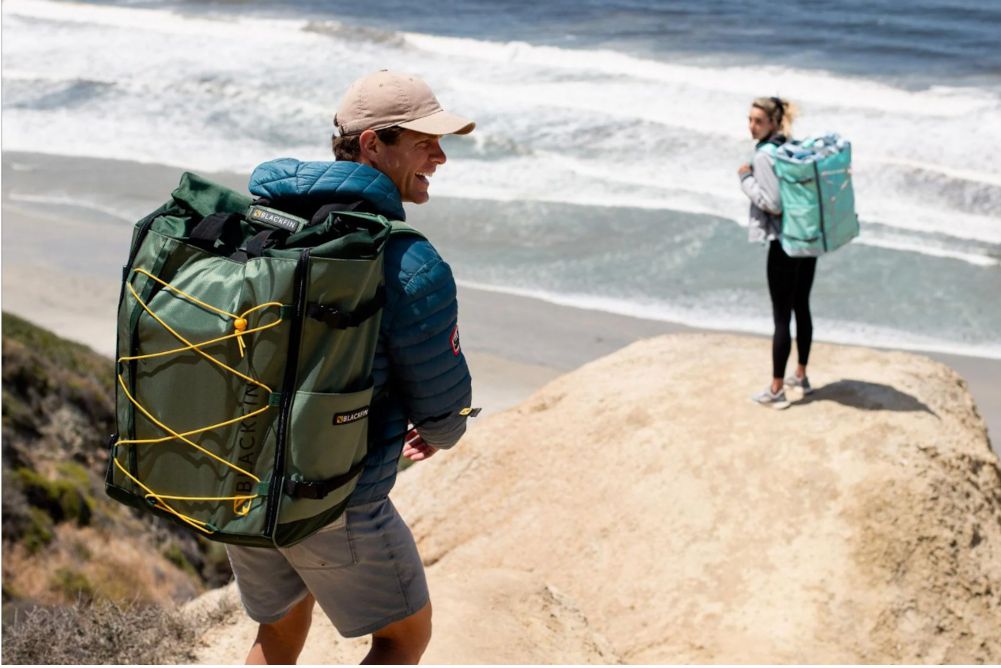
Kayaks, while also available in inflatable versions, tend to be bulkier and heavier, especially the hard-shell varieties. This makes them more challenging to transport and requires more storage space. Inflatable kayaks, although more portable than their hard-shell counterparts, can still be more cumbersome compared to inflatable paddle boards. Ultimately, if ease of transport and storage are high on your priority list, an inflatable SUP might be the way to go.
6. Overall Fun Factor
Moving onto the overall fun factor in the debate between paddle boards and kayaks, SUPs often take the lead.
The versatility of stand up paddle boarding is a thrilling experience for all ages, where you can paddle with kids, bring your dog along, or even engage in SUP yoga. The standing position on a SUP board offers a unique workout and is one of the most engaging ways to explore the waters. The ability to jump off for a swim and easily climb back on adds to the fun.
Kayaks, while offering a different kind of enjoyment, typically provide a more focused and traditional paddling experience. They are excellent for longer, more serene journeys and are perfect for those who enjoy a more relaxed approach to water exploration.
7. Perspective for Sightseeing
For sightseeing, paddle boards offer a distinct advantage over kayaks. The elevated standing position on a SUP provides a better vantage point, allowing you to enjoy a view of your surroundings, both above and below the water's surface. This feature is particularly beneficial for nature observation, wildlife spotting, and simply taking in the scenic beauty.
In contrast, kayaks sit lower in the water, which can limit your range of sight, especially for viewing distant landscapes or spotting wildlife. However, they still offer a close-to-water experience that many find appealing, especially when navigating through narrow waterways or exploring hidden nooks.
8. Cold Weather Paddling
In colder conditions, kayaks generally provide a more suitable option than paddle boards. The seated position in a kayak helps shield you from the wind and keeps you drier, reducing exposure to the cold. This makes kayaks a preferred choice for paddling in chilly weather or in colder water bodies.
On the other hand, SUPs can be more challenging in cold conditions due to the exposed standing position. This exposure can lead to increased cold and wind exposure. However, with the right gear and clothing, paddle boarding is still possible and enjoyable in colder climates, though it requires a higher tolerance for the cold.
9. Warm Weather Paddling
Regarding warm weather, stand up paddle boards offer a delightful experience. The advantage of SUPs in warmer conditions is their open design, allowing you to easily cool off. Feeling the water splash on your feet and the ability to jump in for a swim enhances the paddling experience. Additionally, the standing position on a SUP exposes you to refreshing breezes, making it a joy on hot days.

Kayaks, while less open compared to SUPs, still offer a pleasant experience in warm weather. They provide a more sheltered paddling experience, which can be beneficial for sun protection but might limit the ease of cooling off.
10. Paddling Long Distances
For long-distance paddling, kayaks are often the better choice. The seated position in a kayak makes it easier to cover longer distances, offering more stability and less physical strain compared to standing on a SUP. Kayaks are also generally faster and more efficient in the water, making them ideal for extended journeys.
On the other hand, while SUPs can be used for long distances, they demand more physical effort, particularly in maintaining balance and posture over extended periods. This can be more tiring, especially for less experienced paddlers.
11. Affordability
Both paddle boards and kayaks span a wide price range from entry-level to high-end models. The cost ultimately depends on the specific features, brand, and material quality you're looking for.
12. Durability
Kayaks often have a slight edge, especially in rougher conditions for their durability. They are typically built to withstand impacts and are less susceptible to damage from rocks and other obstacles. SUPs, while also durable, have vulnerable parts like fins that can be damaged in shallow or rocky waters. However, the durability of both kayaks and SUPs greatly depends on their construction materials and design.
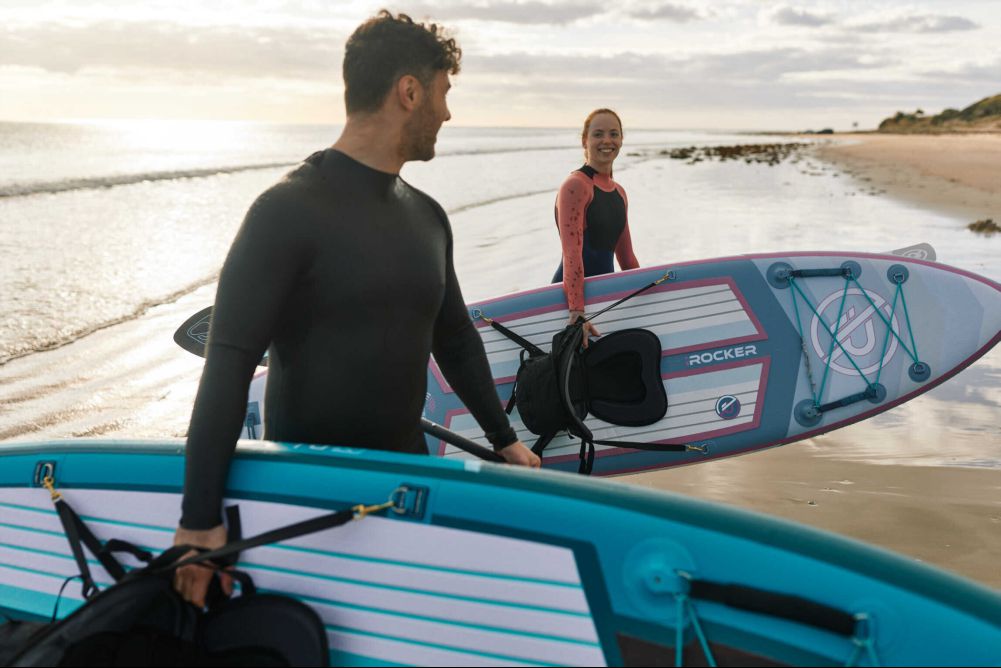
13. Maneuverability
Generally, shorter kayaks and SUPs are more agile and easier to turn, ideal for navigating tight spaces. Longer models provide better tracking and speed but are less maneuverable.
The choice between a kayak and a SUP in terms of maneuverability will depend on the specific water conditions and personal paddling preferences.
14. Speed
When speed is the priority, kayaks generally outpace paddle boards. Thanks to their streamlined shape and lower center of gravity, kayaks cut through the water more efficiently. This design, coupled with a double-bladed paddle, allows for quicker and more powerful strokes, making kayaks faster over distances. Conversely, paddle boards, while offering their own set of advantages, typically lag in speed due to their wider shape and single-blade paddles.
15. Comfort
Comfort levels differ markedly between kayaks and SUPs. Kayaks, with their seated paddling position, provide more support and comfort, especially over longer distances or during extended periods of paddling.
In contrast, paddle boards require standing, kneeling, or sitting directly on the board, which can be more physically demanding and less comfortable for some individuals, particularly on longer excursions.
16. Paddling in Windy Conditions
In windy conditions, kayaks offer a more manageable and less challenging experience. Their low profile and seated position reduce wind resistance, making them easier to control and navigate when the wind picks up.
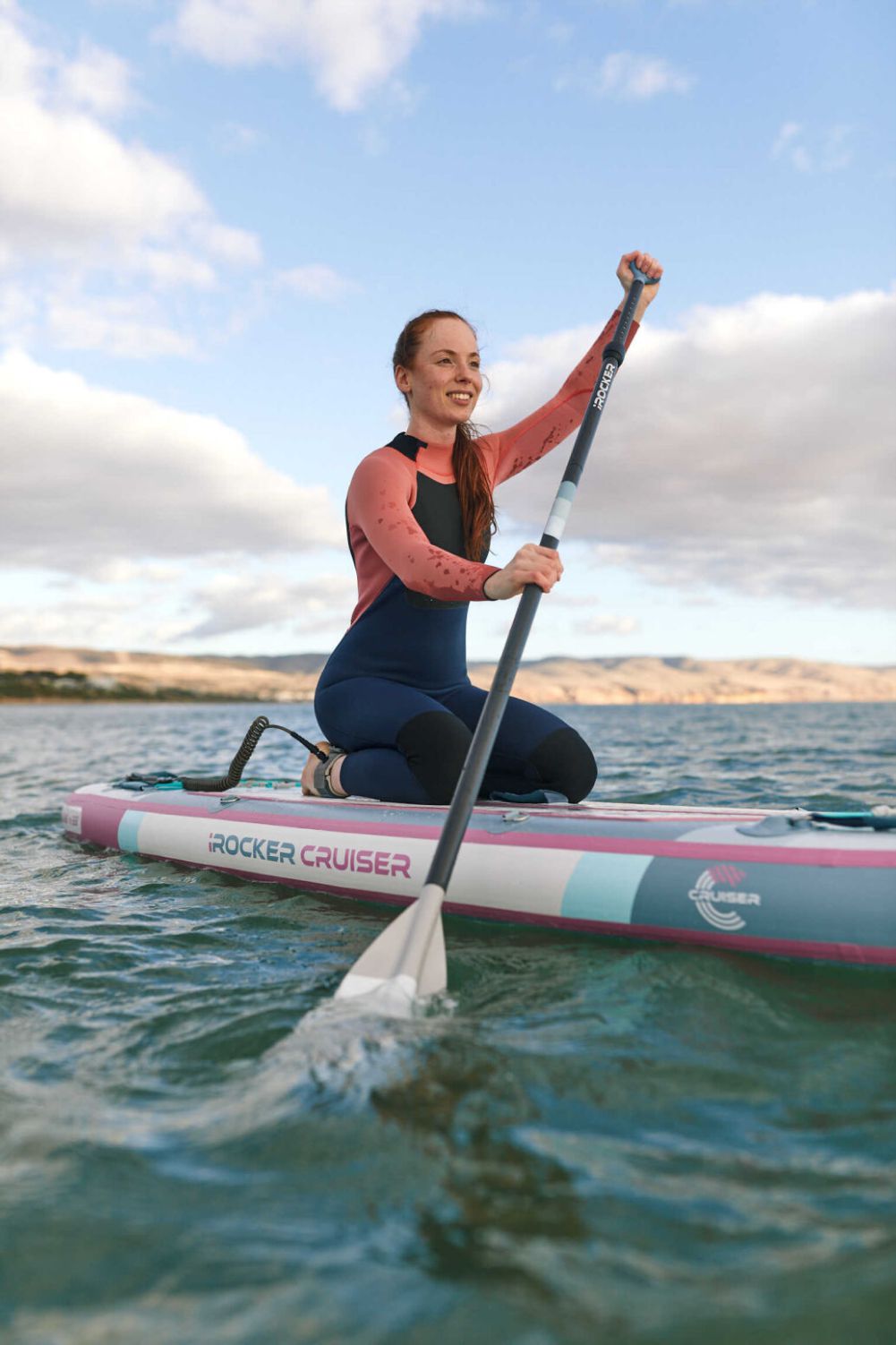
Paddle boards, with their higher stance and larger surface area, can be more difficult to handle in windy conditions, as they are more affected by wind and waves. However, knowing the best wind conditions for paddle boarding can greatly enhance the experience. Paddlers on SUPs may need to adopt a kneeling position to reduce wind resistance and maintain control in less than ideal conditions.
17. Freedom of Movement
Paddle boards excel in offering freedom of movement. On a SUP you can sit, stand, kneel, or even lie down, giving you a range of options to enjoy your time on the water, which is ideal for those who love to move around, stretch, or engage in activities like yoga.
In contrast, kayaks, with their fixed seating positions, limit movement to primarily paddling and shifting within the confines of the cockpit. While this is ideal for stability and long-distance travel, it doesn't match the versatility of movement that a SUP provides.
18. Fishing
Fishing from a kayak has been popular for a long time, and for good reason. Kayaks offer stability, ample storage for gear, and the ability to navigate various water conditions easily. However, fishing from a paddle board is gaining popularity.
SUPs offer an elevated view for spotting fish and greater mobility to cast lines. The choice between a kayak and a SUP for fishing largely depends on personal preference, the fishing environment, and the type of fishing experience you're looking for.
19. Yoga
When it comes to yoga, paddle boards are the clear winner. The flat, stable surface of a SUP makes it an ideal platform for yoga on the water, adding a layer of balance and tranquility to your practice. This isn't feasible in a kayak, which is designed for seated paddling.
SUP yoga challenges your core, balance, and focus, enhancing the overall yoga experience by integrating the soothing elements of being on the water.
20. Sun Protection
When sun protection comes into play, kayaks generally offer more coverage than paddle boards. When you're seated in a kayak, a significant part of your body is shielded from direct sunlight, particularly the lower body and, to some extent, the torso.
In contrast, stand up paddle boarding exposes almost your entire body to the sun, as you're standing upright on the board. This exposure makes it crucial to wear protective clothing and use sunscreen while on a SUP, especially during peak sun hours.
21. Accessibility
Considering accessibility for beginners, stand up paddle boards often have an edge over kayaks. SUPs are renowned for their stability and ease of use, making them more accessible for first-timers. The process of getting onto a paddle board is straightforward, and the simplicity of standing or kneeling on it allows new paddlers to quickly gain confidence.
Kayaks, while also beginner-friendly, present a slightly steeper learning curve. The skills required for entering, exiting, and maneuvering a kayak, as well as dealing with a potential capsize, can be more challenging for novices. Additionally, the easy reboarding of a SUP in water makes it a more suitable option for beginners concerned about falling off and getting back on.
Paddle Board vs Kayak: Finding the Right Equipment
Choosing between a paddle board vs kayak depends on your preferred physical challenge, water type, and recreational interests. Consider these factors when selecting the right equipment:
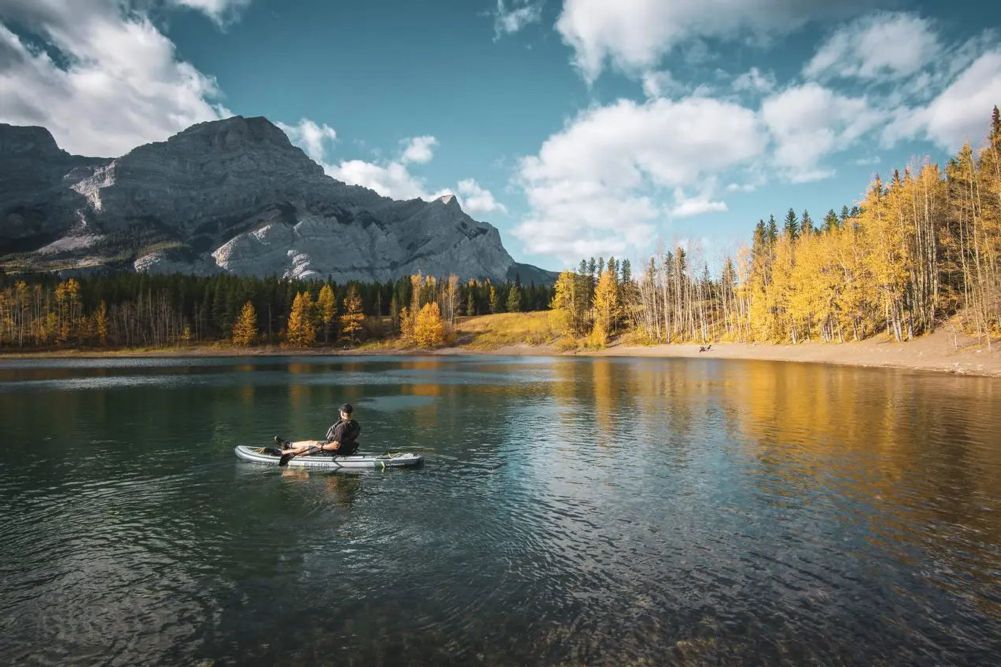
- Purpose: Determine your desired activities such as touring, fishing, or racing. Kayaks are suitable for longer trips, while paddle boards excel in leisurely exploration and can be used as fishing platforms.
- Skill Level: For beginners, choose a sturdy, easy-to-use option. Inflatable paddle boards suit new users, while sit-on-top kayaks are ideal for those with less paddling experience or those who have difficulties with balance.
- Water Conditions: Consider the type of water you'll be navigating. Paddle boards perform well in calm waters like lakes and bays, while kayaks are more versatile and can handle various conditions, including choppy seas and even rapids.
- Storage and Transport: If storage and transport are concerns, consider an inflatable paddle board or an inflatable kayak, as they are more compact and easier to carry and store.
- Budget: Paddle boards and kayaks come in a wide range of prices. Determine your budget and compare the available options within your price range.
How to Convert Your SUP Into a Kayak
Love the idea of both paddle boarding and kayaking? Why not transform your stand-up paddle board (SUP) into a kayak for the best of both worlds? Here's how to make the switch:
- Ensure compatibility: Your SUP must have attachment points for a kayak seat and adequate space for comfortable seating.
- Get a kayak seat: Purchase a paddle board seat specifically designed for SUP-to-kayak conversion. These seats attach using straps and D-rings or clips.
- Find a kayak paddle or converter: You'll need a double-bladed kayak paddle or a converter kit to transform your single-bladed SUP paddle into a double-bladed kayak paddle.

With the necessary kayak attachments in hand, attach the seat to your SUP, adjust the straps for a secure and comfortable fit, and swap out your paddle. Voilà! You've got yourself a hybrid watercraft for a versatile experience.
Paddle boards vs kayaks each boasts distinctive perks and quirks. To choose the ideal watercraft, weigh factors such as skill level, water conditions, intended use, storage, transport, and budget.
Set out on an unforgettable adventure with the perfect watercraft from iROCKER's extensive collection. Seize the day and experience the thrill of the open water. Happy paddling!
FAQs
Can a SUP keep up with a Kayak?
It depends on the conditions and the skill of the paddler. In calm water and over short distances, a skilled paddler on a SUP can keep up with a kayak. However, over longer distances or in rougher water, a kayak is generally faster and more efficient.
Is SUP with a kayak seat slower than a real kayak?
Yes, a SUP with a kayak seat is typically slower than a real kayak. The wider and less streamlined shape of a SUP increases drag, making it less efficient and slower compared to the streamlined design of a kayak.

San Diego is a great destination for paddle boarding enthusiasts, as its stunning coastline, year-round sunshine, and pleasant temperatures provide an ideal environment for the sport. Whether you're a beginner or a pro, you'll find plenty of amazing paddle board San Diego spots. In this guide, we'll take you through some of the top locations for every skill level.
DISCLAIMER: Before traveling to a paddle location, ensure that the location still allows for paddle boarding and make yourself aware of any rules and regulations in place.
1. La Jolla Shores
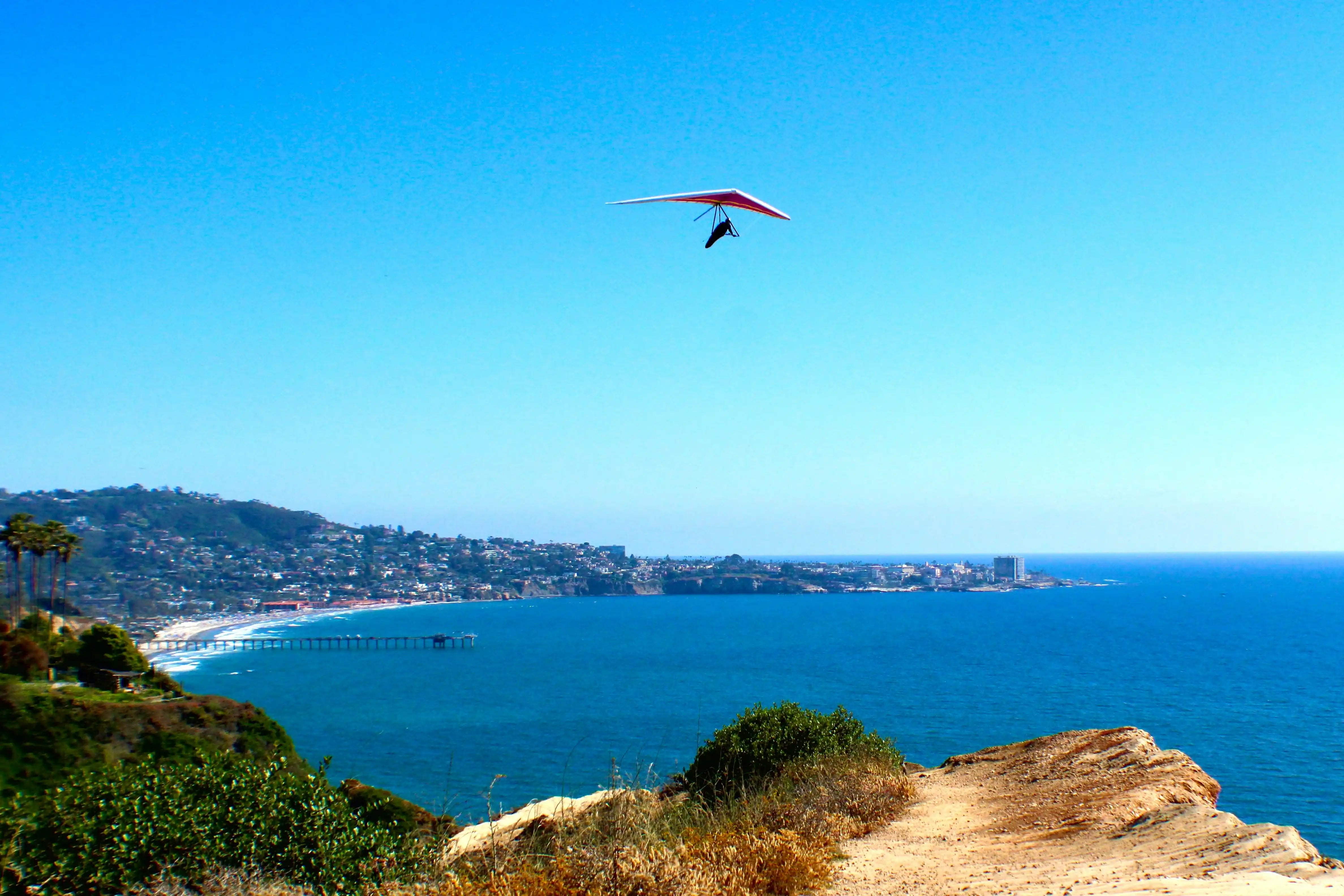
- Experience scenic beauty and marine life
Immerse yourself in the enchanting beauty of La Jolla Shores, where crystalline waters, velvety sands, and majestic cliffs weave a dreamscape for your paddle boarding adventure. As you glide through the mesmerizing La Jolla Underwater Park, be amazed by the beautiful marine life that calls it home—graceful leopard sharks, elusive sea turtles, and vivid fish species. Cherish this rare opportunity to connect with these magnificent creatures in their pristine habitat.
- Ideal for all skill levels
Embrace the gentle waves and serene conditions at La Jolla Shores as you embark on your paddle boarding San Diegojourney. Whether you're a novice discovering the joy of this sport or a seasoned enthusiast, this idyllic spot caters to all. Experienced paddlers can push the boundaries, exploring the alluring La Jolla sea caves and unveiling a thrilling layer to their on-the-water escapades.
2. Mission Bay
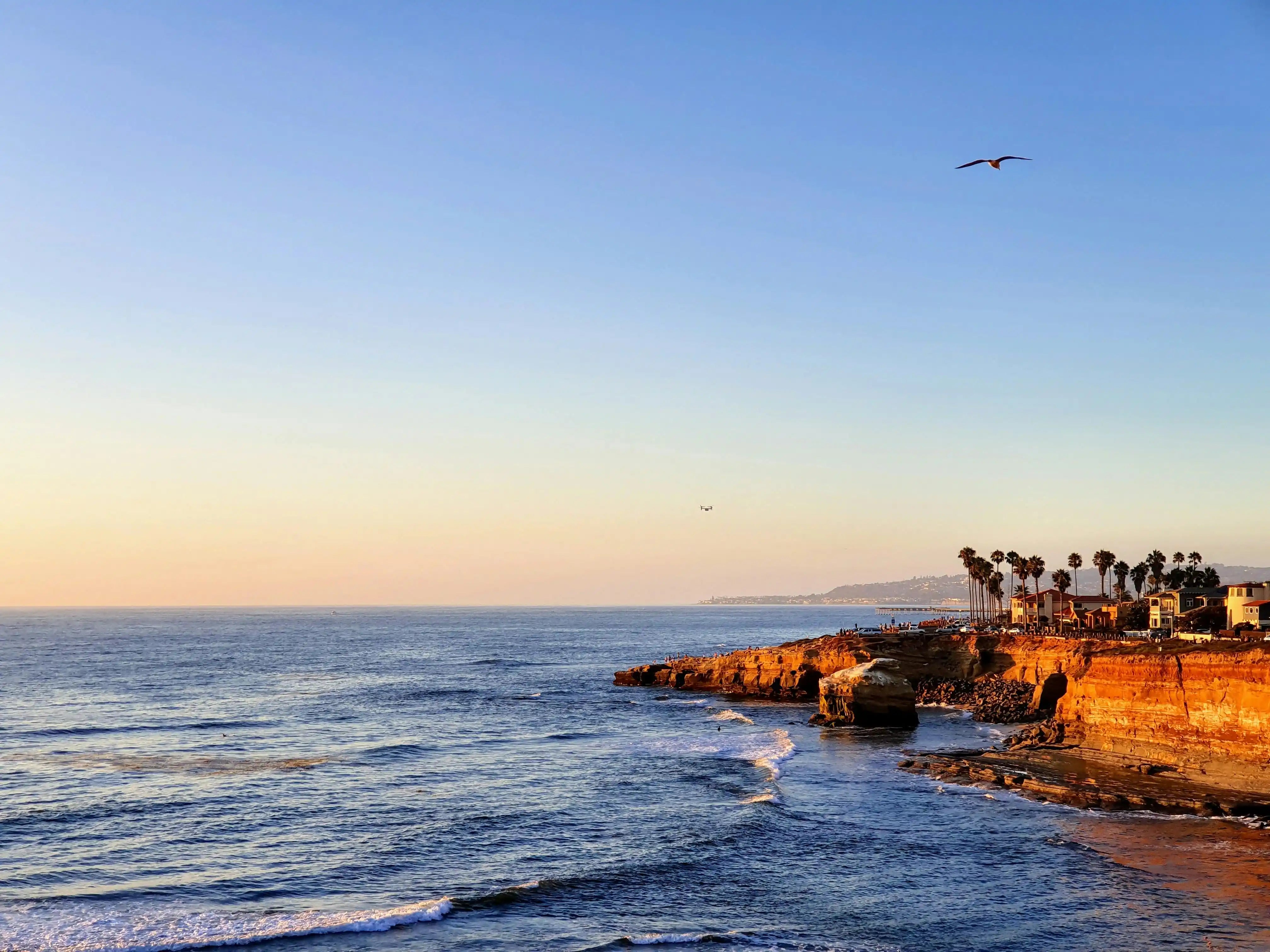
- Tranquil waters and serene surroundings
Discover the wonders of Mission Bay, a sprawling oasis boasting over 4,200 acres of waterways and 27 miles of picturesque shoreline. The bay's sheltered waters provide a calm setting for paddle boarding enthusiasts of all skill levels. Lose yourself in the myriad of captivating coves and inlets as you explore this aquatic paradise on your paddle board.
- The ultimate family and group destination
Embrace the inviting ambiance of Mission Bay, where lush parks, playful playgrounds, and charming picnic spots create the perfect backdrop for family outings or group adventures. With easy access to paddle board rentals, lessons, and guided tours at various locales around the bay, planning a delightful day on the water has never been simpler or more enjoyable.
3. Carlsbad Lagoon
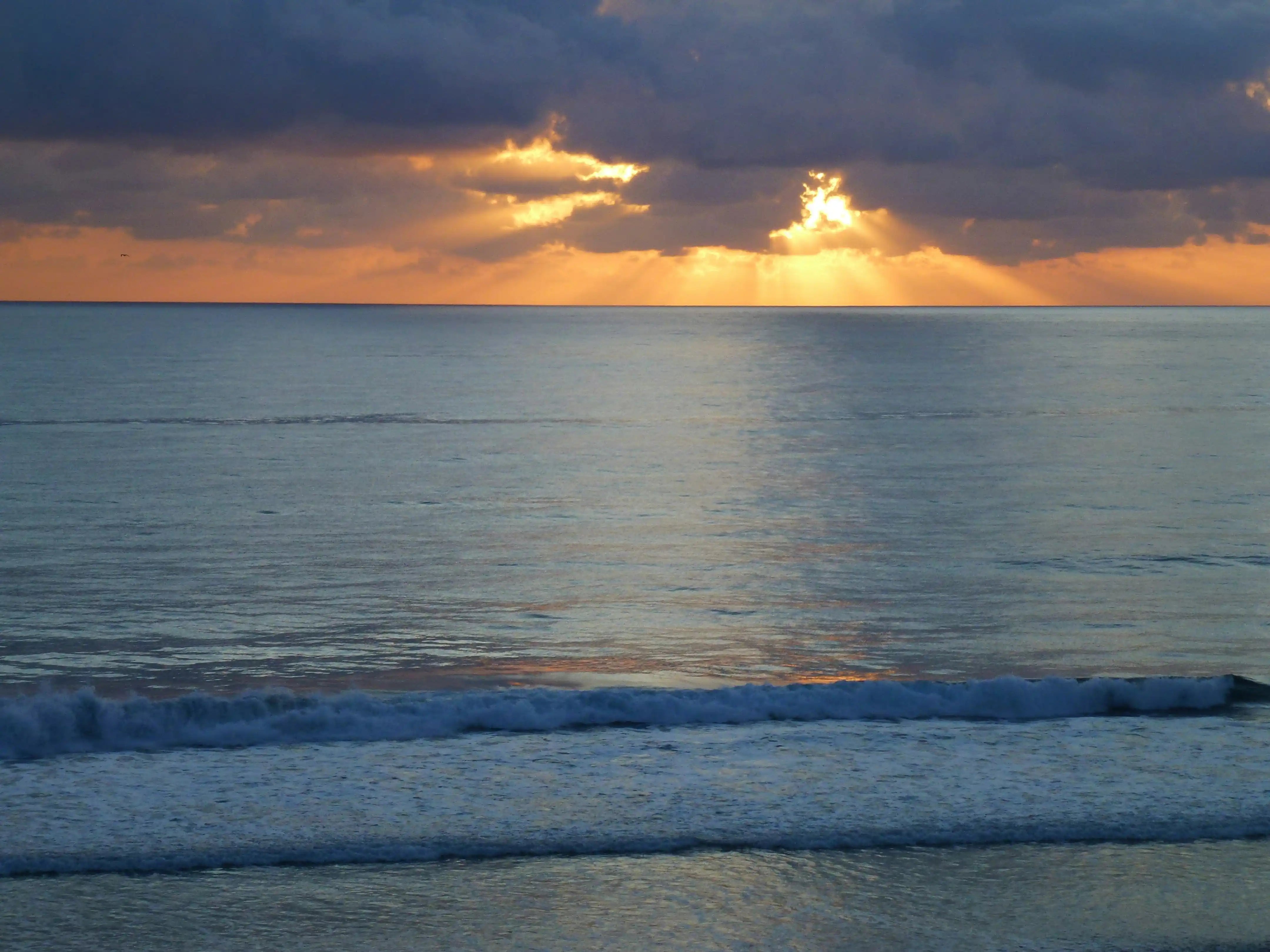
- Serene Haven for a blissful paddle boarding escape
Escape to the tranquil sanctuary of Carlsbad Lagoon, nestled in North County San Diego. This secluded treasure offers a respite from crowded beaches, beckoning those who yearn for a laid-back paddle boarding experience. Drift through the lagoon's calm waters, surrounded by enchanting scenery, and let the world fade away as you savor this blissful retreat.
- Witness nature's splendor up close
Delight in the abundant wildlife sightings as you paddle board through Carlsbad Lagoon. Marvel at the grace of herons, pelicans, and other avian species that call this haven home. Keep your eyes peeled for playful sea lions or harbor seals basking in the sun on the shores, adding a touch of magic to your unforgettable paddle boarding San Diego adventure.
4. Coronado Island
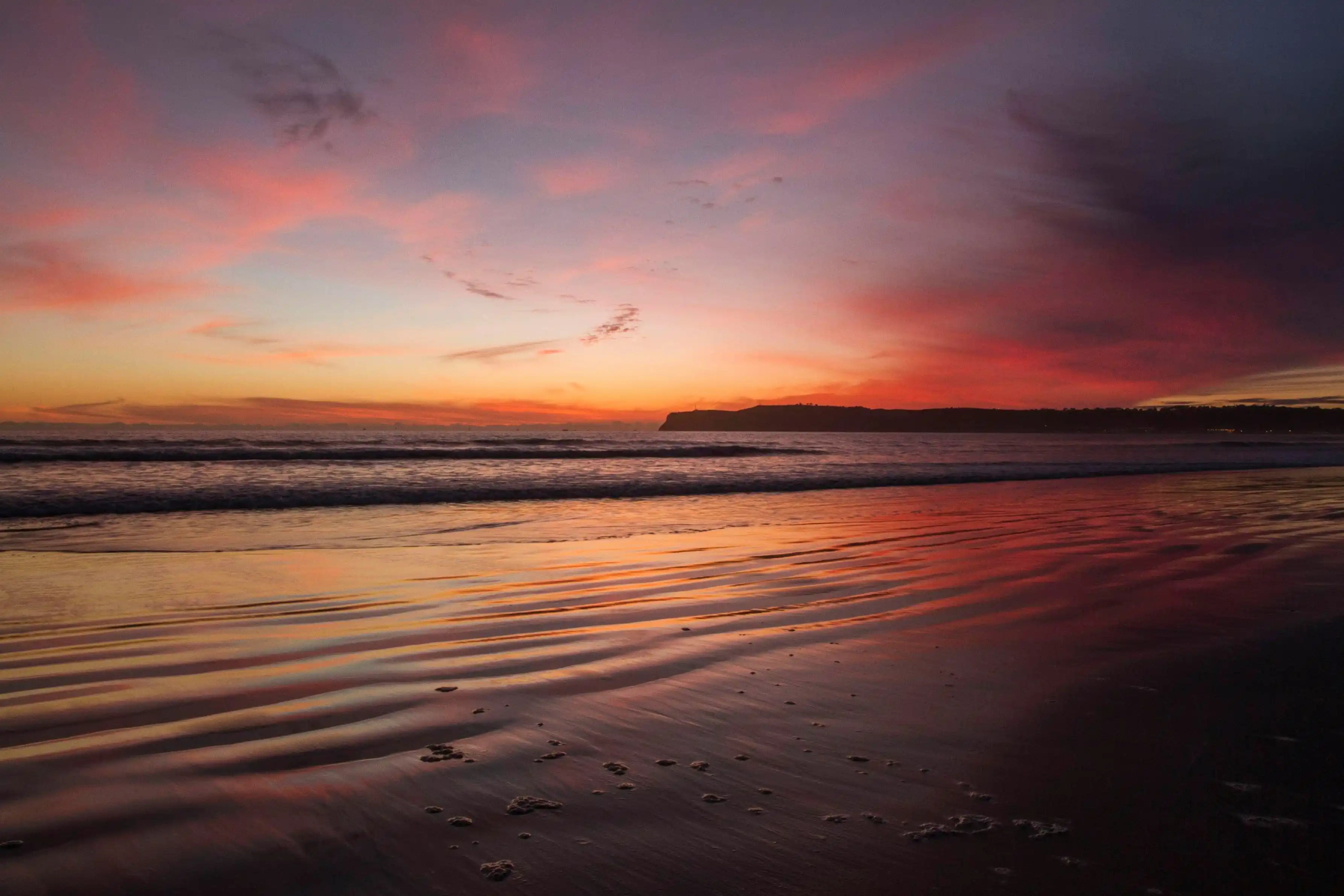
- Spectacular panoramas of the paddle boarding San Diego skyline
Venture to Coronado Island, a stone's throw away from downtown San Diego, and marvel at a unique perspective of the city skyline, best appreciated by the gentle embrace of the waves. Paddle boarding around this picturesque island immerses you in awe-inspiring views while the soothing rhythm of the ocean cradles you.
- Welcoming to paddle boarders of all abilities
The tranquil waters encircling Coronado Island create a haven for paddle boarders of every skill level. With miles of golden shoreline awaiting your discovery, there's always a new adventure to embark upon. Be sure to admire the iconic Hotel del Coronado and the North Island Naval Air Station, both visible from your vantage point on the water.
5. Shelter Island Shoreline Park
This park stretches along the bayside of Shelter Island and offers a public fishing pier as well as a boat launch ramp.
- Scenic spot for a relaxing paddle boarding session
Experience a leisurely paddle boarding San Diego excursion like no other at Shelter Island Shoreline Park - a picturesque and serene oasis nestled in the heart of San Diego Bay. This park provides a spacious and well-maintained launch area, plenty of parking space, and ample amenities to ensure a hassle-free outing. As you glide along the calm and pristine waters, you'll be awed by the stunning views of the bay and the city. Catch glimpses of the local wildlife and enjoy a moment of peace and tranquility amidst the bustling city.
- Discover the variety of marine creatures and historic landmarks.
Paddle board around Shelter Island Shoreline Park and discover the enchanting world of San Diego Bay's biodiversity and cultural heritage. Glide through the tranquil waters and immerse yourself in the mesmerizing scenery of rocky reefs and kelp beds teeming with colorful marine life. Take in the magnificent sight of majestic ships and submarines anchored at the nearby naval base and maritime museum, a testament to the region's fascinating history. Get ready for an unforgettable experience that will leave you spellbound.
6. Oceanside Harbor
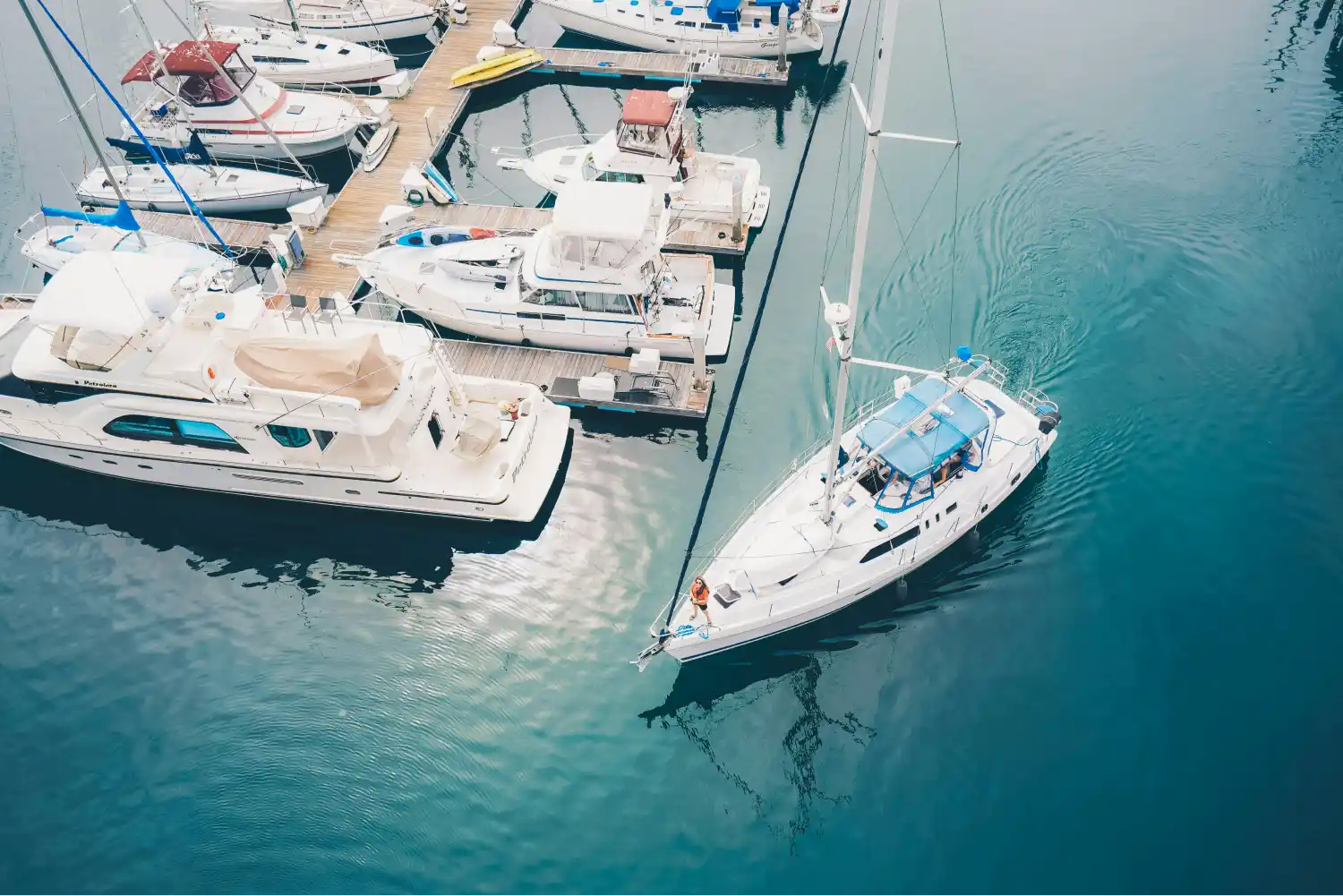
- Thrilling destination for a challenging paddle boarding adventure
Come and enjoy the excitement of paddle boarding San Diego at Oceanside Harbor, a busy port in North County, San Diego. You can experience different conditions here, ranging from gentle waves to strong currents, which will challenge your skills and fitness level. Get your adrenaline pumping as you navigate the choppy waters, avoiding boats and jet skis, and relish in the thrill of this dynamic sport.
- Enjoy the vibrant atmosphere and amenities of the harbor.
Explore the beautiful Oceanside Harbor with its lively atmosphere and numerous attractions. Take a leisurely paddle board ride around the harbor's perimeter and take in the stunning views of the sparkling waters and picturesque surroundings. You can also enjoy delicious meals and refreshing drinks at the harbor's waterfront restaurants and bars and shop for unique items at charming boutiques and shops. The sandy beach is perfect for relaxation and sunbathing. There are also many fun activities and events throughout the year that you can join.
7. Agua Hedionda Lagoon
- A pristine paradise for a peaceful paddle boarding escape
Escape to the pristine beauty of Agua Hedionda Lagoon, a coastal wetland located in Carlsbad. This lagoon offers a tranquil setting for a relaxing paddle boarding San Diego experience, away from the crowds and noise of the city. Paddle through the clear waters, surrounded by lush vegetation and rolling hills, and let the soothing sounds of nature calm your senses.
- Explore the lagoon's abounding animals and natural delights.
Let’s experience the rich biodiversity and natural wonders of Agua Hedionda Lagoon as you explore its three basins on a paddle board. Encounter the rare and endangered species that inhabit the lagoon, such as the least tern, the snowy plover, and the tidewater goby. Learn about the environmental conservation and education efforts of the Agua Hedionda Lagoon Foundation, which operates a discovery center and hosts various programs and events.
8. Del Mar - Dog Beach
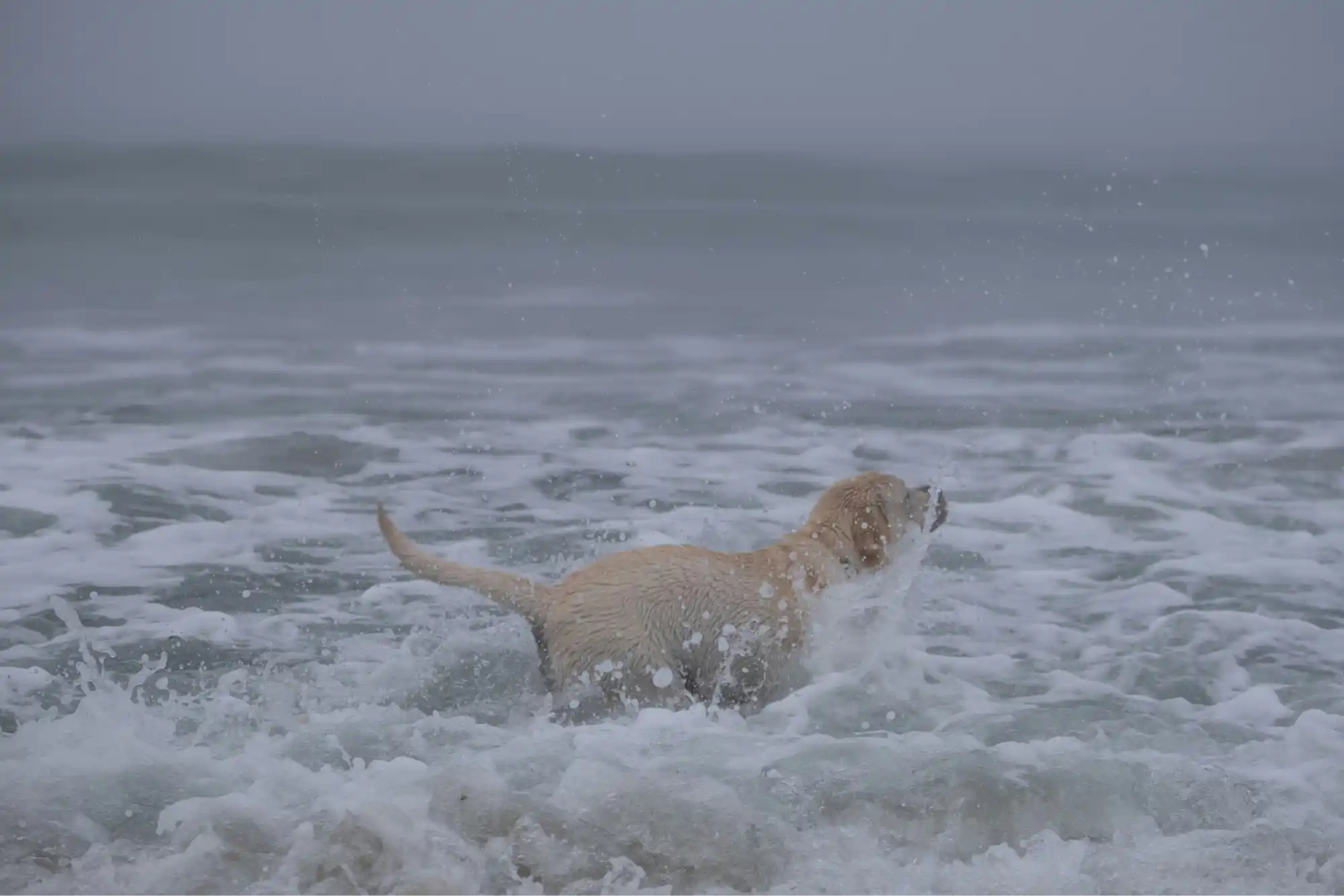
- A fun-filled destination for a paddle boarding adventure with your furry friend
Bring your canine companion along for a paddle boarding San Diego adventure at Del Mar - Dog Beach, a popular spot for dog lovers and their pets. This beach offers a wide stretch of sand and surf, where you and your pup can enjoy the sun and the sea. Paddle board with your dog on the calm waters of the San Dieguito River mouth, or ride the waves of the Pacific Ocean.
- Socialize with other dog owners and their pooches.
Looking to make new friends and spend some quality time with your furry companion? Del Mar - Dog Beach is the perfect place for you! This friendly and welcoming community gives you the chance to bond with other dog owners and their pooches. Whether you want to share tips and stories, play games, or join a group paddle boarding session with fellow dog lovers, you'll find it all here. However, it's important to follow the rules and etiquette of the beach to ensure everyone has a good time. Remember to keep your dog on a leash, pick up after your dog, and respect other beachgoers.
9. Liberty Station
- Historic site for a paddle boarding exploration of San Diego’s past
Immerse yourself in the history and culture of San Diego with a paddle boarding excursion around Liberty Station. Once a naval training center, this site has undergone a remarkable transformation into a bustling arts and entertainment district. As you glide along the water, you'll be able to admire stunning views of the city's skyline while discovering the stories of its past, present, and future.
The area boasts numerous historic buildings, monuments, and artworks, each with unique significance. From the towering white columns of the North Chapel to the intricate mosaics of the Rose Garden, there's no shortage of beauty to behold. Whether you're a San Diego resident or just visiting, you won't want to miss out on the incredible paddle boarding experience we offer. It's the perfect way to truly immerse yourself in the city's vibrant culture and rich history.
- Experience the diverse offerings and attractions of Liberty Station.
Explore the various attractions and offerings at Liberty Station's waterfront by paddling board. You can taste the delicious food and drinks available at Liberty Public Market or check out the unique shops and galleries located in the Arts District. There are also live music performances and festivals that take place at the different venues and parks. If you prefer, you can simply sit back, relax, and enjoy the beautiful views of the bay and downtown skyline.
10. Lake San Marcos
This is the only lake in San Diego County where stand-up paddle boarding is permitted.
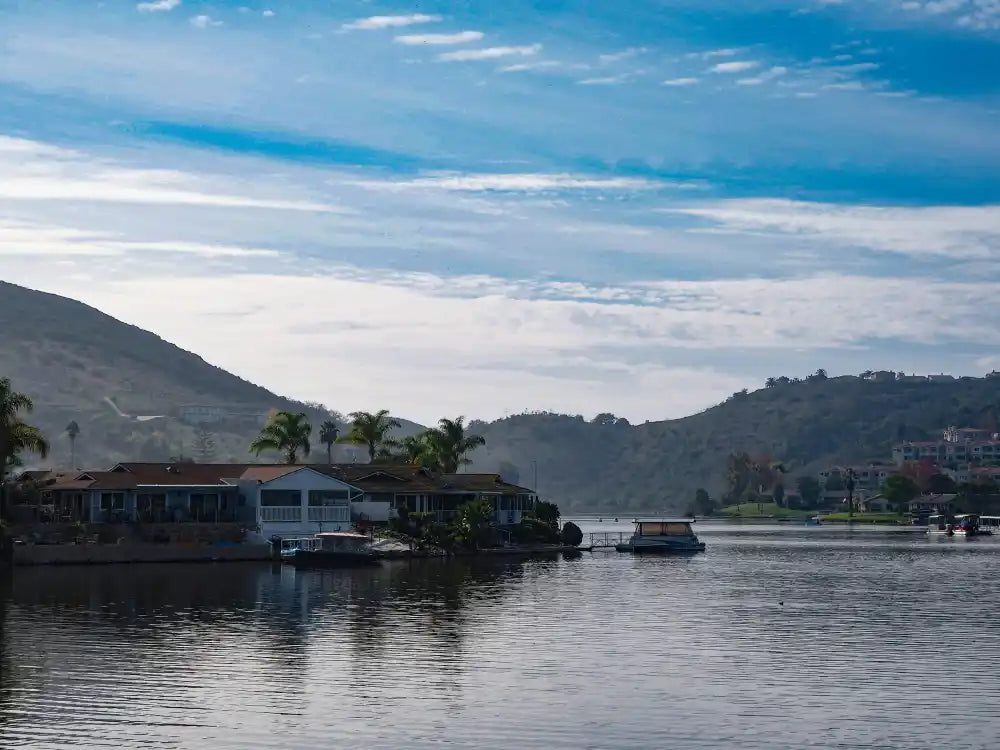
- Serene lake for a refreshing paddle boarding getaway
Enjoy a refreshing paddle boarding San Diego getaway at Lake San Marcos, a man-made reservoir located in North County, San Diego. This lake offers a serene and scenic setting for a relaxing paddle boarding experience, with clear waters, gentle breezes, and picturesque views. Paddle at your own pace, or join a guided tour or a yoga class on the water.
- Indulge in the amenities and activities of the lake resort.
Indulge in the amenities and activities of the Lake San Marcos Resort, a luxury destination that caters to your every need. Stay at the elegant hotel, or rent a cozy cottage or a spacious villa. Dine at the fine restaurants, or enjoy a picnic by the lake. Play golf, tennis, or other sports at the well-equipped facilities. Or pamper yourself at the spa, salon, or fitness center.
11. Tourmaline Surf Park
- An epic spot for a paddle boarding San Diego adventure on the waves
Experience the thrill of paddle boarding on the waves at Tourmaline Surf Park, a legendary surf spot located on Pacific Beach. This park offers consistent and moderate waves, ideal for beginners and intermediate paddle boarders. Feel the rush as you catch and ride the waves, or watch the pros show off their skills and tricks.
- Enjoy the laid-back vibe and culture of the surf park.
If you're looking for a relaxed atmosphere and a place to connect with other surfers and paddle boarders, Tourmaline Surf Park is a great option. People of all ages and backgrounds gather here to enjoy the ocean and its waves. You can chat with the locals or consider joining a club or a group session to learn and improve your skills. Remember, it's important to respect the rules and etiquette of the park to ensure everyone's safety and enjoyment.
Best Time for Paddle Boarding in San Diego
San Diego is blessed with over 70 miles of beautiful coastline, allowing you to go paddle boarding all year long. But for an unforgettable adventure, embark on your journey between May and October. During this sun-kissed season, the ocean's warm embrace at a balmy 66-72°F (19-22°C) encourages you to indulge in extended paddling sessions. The serene summer sea creates the perfect canvas for your paddle boarding adventures.

But don't overlook the cooler months! San Diego's moderate winter climate still offers ample sunshine for your paddle boarding escapades. With fewer crowds, you'll savor a tranquil, intimate connection with the ocean. Just slip into a snug wetsuit and let it keep you cozy as you revel in the beauty of the sea.
Getting Started with Paddle Boarding in San Diego with iROCKER
With its breathtaking shores, numerous paddle boarding San Diego spots, and endless paddling possibilities, San Diego is truly the ultimate destination for heart-pumping aquatic adventures. Whether you're a seasoned pro or just getting started, there's always a new adventure waiting for you. So gear up, grab your iROCKER paddle board, and get ready to experience the magic of paddle boarding in San Diego.

Our Promise, Beyond the Paddle
We're driven by purpose—and powered by the outdoors. From product quality to environmental action, here's what we stand for:
We guarantee the quality of our products.
With paddles in our hands and adventure in our soul, we focus on top-quality manufacturing, design, and functionality.
Learn more
